#passing data between components
Explore tagged Tumblr posts
Text
Trying to use a professional architecture for an app is like navigating a fucking maze
#i still haven't been able to write down all the connections between files properly because there's just so much#i think that between the last ui component to the first data file there are uhhhh around 9 files?#JUST TO PASS THE SAME INFORMATION#I UNDERSTAND WHY MAINTAINING CODE THIS WAY IS A MILLION TIMES EASIER BUT OH MY GODDDDD#it's hell to remember all this stuff with my shit memory
2 notes
·
View notes
Note
She’s a Ferrari engineer and different people in the paddock can see how down bad Toto is for her every time they interact.
Downshift
back to my main masterlist
pairing: toto wolff x ferrari engineer (OC)
summary: toto wolff’s efficiency is legendary. His focus, unwavering. Until she arrives in the paddock as Ferrari’s newest engineer, and everyone starts noticing how he suddenly seems… distracted.
warnings: romantic tension, open ending


The paddock was alive with its usual hum of activity, journalists darting from one garage to another, engineers poring over data, and drivers engaging in last-minute interviews. It was a world of precision, discipline, and focus. Toto Wolff was the embodiment of all three.
Or at least, he had been.
The first meeting of the weekend started like any other: strategy briefs, discussions about weather conditions, and subtle jabs traded between rival teams. But today, something felt different. Toto wasn’t his usual commanding self. He wasn’t distracted by the numbers or even Christian Horner’s persistent prodding. No, his attention was elsewhere.
Her.
She was Ferrari’s newest addition, a sharp-minded engineer whose reputation for innovation had preceded her arrival. As she spoke, the room seemed to narrow, her words slicing through complex issues with ease. She didn’t just command respect, she demanded it. And Toto, much to his dismay, couldn’t look away.
—Wolff. —Horner’s voice broke through the discussion. —any thoughts?
Toto blinked, his focus snapping back. —It’s a solid plan. —he said quickly, his tone as measured as ever. But Lewis Hamilton, seated nearby, caught the faintest crack in his composure.
As the meeting ended and the attendees filed out, Lewis leaned in. —You good, boss? —he asked, his voice low. —You looked… distracted.
Toto straightened his tie, his expression impassive. —Focus on the race, Lewis.
But the day only got worse.
By mid-afternoon, the whispers had started.
—Did you see the way Wolff was watching her during the meeting?
—I’m telling you, he actually smiled. Toto Wolff smiled.
—Maybe he’s trying to poach her for Mercedes?
The rumors spread like wildfire, and Toto did little to dispel them. Every time he crossed paths with her, his usual cool demeanor seemed to falter. A second too long holding a door. A fleeting glance across the paddock. A barely-there smile when she passed by.
She noticed, of course. How could she not? She was sharp enough to catch the tension in his posture, the way his eyes lingered just a moment longer than necessary. And if she felt a twinge of satisfaction, she hid it well, burying it beneath a professional facade.
The real breaking point came during a rainy afternoon session. The rain had turned the pit lane into chaos. Engines roared, tires screeched, and mechanics scrambled to adapt. She was in the thick of it, crouched near the Ferrari garage with grease smudging her cheek as she adjusted a temperamental component.
Toto passed by, his stride slowing involuntarily. She looked up just as he did, their eyes locking for a split second. There it was again. That soft smile tugging at the corner of his mouth, the one that felt entirely out of place for someone as composed as him.
—Something caught your eye, Wolff? —Christian Horner’s voice interrupted, smug as ever. He was leaning against the Mercedes garage, arms crossed and a grin firmly in place.
Toto’s jaw tightened, his gaze flicking to Horner before he resumed walking. —Focus on your own team, Christian. —he said evenly, but the slight flush on his face didn’t go unnoticed.
Later that evening, the paddock had quieted, the storm outside matching the subdued atmosphere. She found herself alone in the Ferrari garage, organizing tools when she heard footsteps behind her.
—Toto. —she said without looking up, her voice tinged with amusement.
He froze, caught. —You’re very observant. —he admitted, stepping closer.
—I’d have to be, working in this world. —she replied, finally meeting his gaze. There was something playful in her eyes, a spark that set his nerves alight. —So, what can I do for you?
For a moment, he said nothing, his carefully constructed walls crumbling under the weight of her stare. Finally, he managed. —You’ve made quite an impression.
Her smile widened, slow and deliberate. —Have I? Because from what I hear, you’re the one making impressions, Toto.
He didn’t answer. He didn’t need to. The paddock had already done enough talking for both of them.
As he walked away, leaving her smirking in the quiet garage, Toto couldn’t shake the feeling that, for the first time in years, he was driving blind. And yet, he wasn’t sure he minded.
#totowolff x you#toto wolff x y/n#toto wolff fluff#toto wolff imagine#toto wolff fanfic#toto wolff x reader#fanfic#toto wolff#torger christian wolff
204 notes
·
View notes
Text
Live stream happened, and we got some designs revealed! As well as a couple of information, but not anything major.

Miss conductor, not much of a surprise (but miss girl looks gorgeous as always)

And Node, who is sort of the main antagonist.
I made a prediction before, and April 21 hit,.. so I believe it is well due for an update by now.
While we did not receive nearly as much information as we were anticipating, a design still reveals much on the character itself when going through the lens of a general analysis. In this context, their abilities and name aid significantly in the status and essential depths of their character.
With what I can gather in my research, nodes play an important role in networking because they are the building blocks of a network, precisely the gateway for connection, direction, sending, creating, receiving, and storing data. It requires only software to connect to the network, and it can be run by completely anyone. Applying this knowledge with concept arts of the game and overall worldbuilding of the series itself—everything becomes a lot clearer.
So now, how can we apply this to Node?

Node's name is simple in itself, and it connects to their design as well. They are quite literally made up of nodes. One in their head and the other in their limbs. Their body is translucent.
Network nodes are categorical. Thanks to DJ, we got a helpful hint that incredibly reduced their types to a digestible and simpler layout.
Their name starts with i.
There are countless forms and types of nodes, the hint condensed it down to 2 answers, both starting with the letter “i”
Intermediate nodes
These include devices like routers and switches that help direct data to the correct destination while also receiving it. They don't originate or terminate data but instead pass it along to where it needs to go.
IoT nodes
loT (Internet of Things) Nodes serve as devices that establish connectivity to the Internet via a gateway, effectively enabling the integration of the physical world into the vast realm of the Internet. Within an loT ecosystem, these nodes function as crucial components for bridging the gap between the physical and virtual worlds. Taking charge of managing the entire loT system.
We had seen this ability before vía King's icons' staff, in which it only sucked in Minecraft mobs due to the strong force being their obligatory origin, overriding the game itself due to the overlapping icons.
In regards to King, he used this ability for the very destruction of the game itself, down to the code, reducing it to nothing but.. nothing for the sake of vengeance. Or at least what would have occurred if he did succeed.
way to go CG! Give credit where it's due
Despite this being marked with the intention of erasion and minimization, I think it's safe to group this as receiving and storing data. The two icons combined created a horrifically dramatized version of the force with storing and receiving, which created an incredibly overpowered demolishing force.

In Chosen, we had seen this ability before as well, as the constellations are seen right as he creates the gateway from the Outernet, which sounds awfully familiar. This is what you would refer to as an "extension to the digital world"
I think I can be able to safely group this to direction and creation.
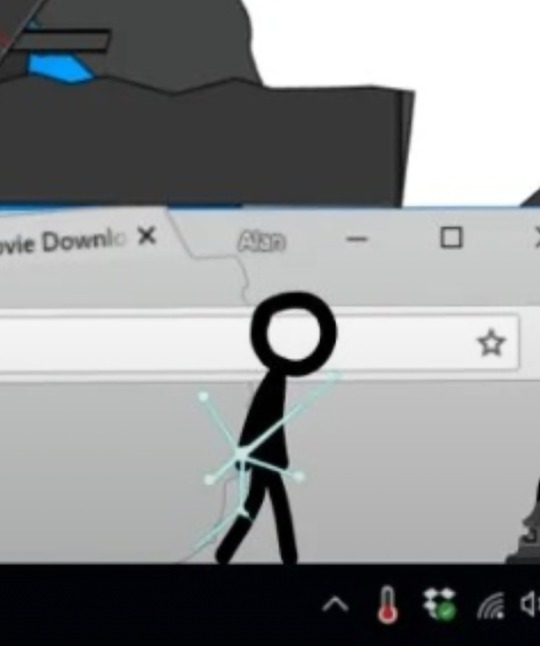

From how I see it, it seems as though it's quite diverse in a fictional worldbuilding sense within characters.
And obviously, it won't be the last time we would see it. It seems as though we would be exploring this quite a lot.

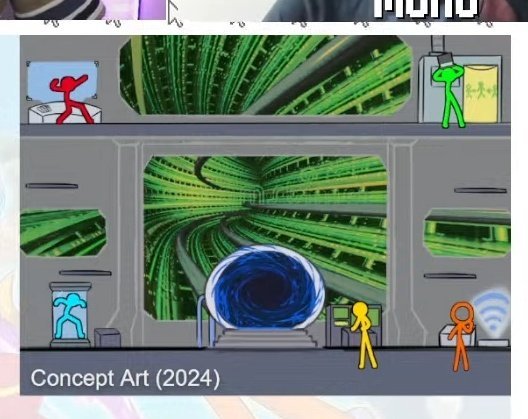
In their cameo, Node is in an assumed line-up with all the major series antagonists.

But if you’re asking me, it seems as though our iconic antagonists appear to be rather victims of Node. Menacingly behind them, their abilities floating not far behind as they're stuck in a swampy substance. But that's just me.
Node's entire antagonistic ordeal is beyond my grasp, but I'm assuming their abilities and attacks surrounds the embodiment of network topology, which would mold and diverse into the connections of nodes. They possibly intend to screw up with the gateways that are responsible for the receiving, directing, and sending of data between various devices through communication links that are defined as network—with the basic visuals of concept art we were given.

(The gateway, ethernet tunnels, the train cough cough)
Node's goal and story behind that destruction remains anonymous, as the writing is still in early development. Regardless, food for thought.
#alan becker#animation vs minecraft#animator vs animation#animation versus#nerd voyage#it's pretty interesting#though my research is still ongoing#when i say it's diverse..#yeah it's diverse alright
87 notes
·
View notes
Text
SysNotes devlog 1
Hiya! We're a web developer by trade and we wanted to build ourselves a web-app to manage our system and to get to know each other better. We thought it would be fun to make a sort of a devlog on this blog to show off the development! The working title of this project is SysNotes (but better ideas are welcome!)

What SysNotes is✅:
A place to store profiles of all of our parts
A tool to figure out who is in front
A way to explore our inner world
A private chat similar to PluralKit
A way to combine info about our system with info about our OCs etc as an all-encompassing "brain-world" management system
A personal and tailor-made tool made for our needs
What SysNotes is not❌:
A fronting tracker (we see no need for it in our system)
A social media where users can interact (but we're open to make it so if people are interested)
A public platform that can be used by others (we don't have much experience actually hosting web-apps, but will consider it if there is enough interest!)
An offline app
So if this sounds interesting to you, you can find the first devlog below the cut (it's a long one!):
(I have used word highlighting and emojis as it helps me read large chunks of text, I hope it's alright with y'all!)
Tech stack & setup (feel free to skip if you don't care!)
The project is set up using:
Database: MySQL 8.4.3
Language: PHP 8.3
Framework: Laravel 10 with Breeze (authentication and user accounts) and Livewire 3 (front end integration)
Styling: Tailwind v4
I tried to set up Laragon to easily run the backend, but I ran into issues so I'm just running "php artisan serve" for now and using Laragon to run the DB. Also I'm compiling styles in real time with "npm run dev". Speaking of the DB, I just migrated the default auth tables for now. I will be making app-related DB tables in the next devlog. The awesome thing about Laravel is its Breeze starter kit, which gives you fully functioning authentication and basic account management out of the box, as well as optional Livewire to integrate server-side processing into HTML in the sexiest way. This means that I could get all the boring stuff out of the way with one terminal command. Win!
Styling and layout (for the UI nerds - you can skip this too!)
I changed the default accent color from purple to orange (personal preference) and used an emoji as a placeholder for the logo. I actually kinda like the emoji AS a logo so I might keep it.
Laravel Breeze came with a basic dashboard page, which I expanded with a few containers for the different sections of the page. I made use of the components that come with Breeze to reuse code for buttons etc throughout the code, and made new components as the need arose. Man, I love clean code 😌
I liked the dotted default Laravel page background, so I added it to the dashboard to create the look of a bullet journal. I like the journal-type visuals for this project as it goes with the theme of a notebook/file. I found the code for it here.
I also added some placeholder menu items for the pages that I would like to have in the app - Profile, (Inner) World, Front Decider, and Chat.

i ran into an issue dynamically building Tailwind classes such as class="bg-{{$activeStatus['color']}}-400" - turns out dynamically-created classes aren't supported, even if they're constructed in the component rather than the blade file. You learn something new every day huh…

Also, coming from Tailwind v3, "ps-*" and "pe-*" were confusing to get used to since my muscle memory is "pl-*" and "pr-*" 😂
Feature 1: Profiles page - proof of concept
This is a page where each alter's profiles will be displayed. You can switch between the profiles by clicking on each person's name. The current profile is highlighted in the list using a pale orange colour.

The logic for the profiles functionality uses a Livewire component called Profiles, which loads profile data and passes it into the blade view to be displayed. It also handles logic such as switching between the profiles and formatting data. Currently, the data is hardcoded into the component using an associative array, but I will be converting it to use the database in the next devlog.

New profile (TBC)
You will be able to create new profiles on the same page (this is yet to be implemented). My vision is that the New Alter form will unfold under the button, and fold back up again once the form has been submitted.
Alter name, pronouns, status
The most interesting component here is the status, which is currently set to a hardcoded list of "active", "dormant", and "unknown". However, I envision this to be a customisable list where I can add new statuses to the list from a settings menu (yet to be implemented).




Alter image
I wanted the folder that contained alter images and other assets to be outside of my Laravel project, in the Pictures folder of my operating system. I wanted to do this so that I can back up the assets folder whenever I back up my Pictures folder lol (not for adding/deleting the files - this all happens through the app to maintain data integrity!). However, I learned that Laravel does not support that and it will not be able to see my files because they are external. I found a workaround by using symbolic links (symlinks) 🔗. Basically, they allow to have one folder of identical contents in more than one place. I ran "mklink /D [external path] [internal path]" to create the symlink between my Pictures folder and Laravel's internal assets folder, so that any files that I add to my Pictures folder automatically copy over to Laravel's folder. I changed a couple lines in filesystems.php to point to the symlinked folder:

And I was also getting a "404 file not found" error - I think the issue was because the port wasn't originally specified. I changed the base app URL to the localhost IP address in .env:

…And after all this messing around, it works!
(My Pictures folder)

(My Laravel storage)

(And here is Alice's photo displayed - dw I DO know Ibuki's actual name)

Alter description and history
The description and history fields support HTML, so I can format these fields however I like, and add custom features like tables and bullet point lists.

This is done by using blade's HTML preservation tags "{!! !!}" as opposed to the plain text tags "{{ }}".
(Here I define Alice's description contents)


(And here I insert them into the template)

Traits, likes, dislikes, front triggers
These are saved as separate lists and rendered as fun badges. These will be used in the Front Decider (anyone has a better name for it?? 🤔) tool to help me identify which alter "I" am as it's a big struggle for us. Front Decider will work similar to FlowCharty.

What next?
There's lots more things I want to do with SysNotes! But I will take it one step at a time - here is the plan for the next devlog:
Setting up database tables for the profile data
Adding the "New Profile" form so I can create alters from within the app
Adding ability to edit each field on the profile
I tried my best to explain my work process in a way that wold somewhat make sense to non-coders - if you have any feedback for the future format of these devlogs, let me know!
~~~~~~~~~~~~~~~~~~
Disclaimers:
I have not used AI in the making of this app and I do NOT support the Vibe Coding mind virus that is currently on the loose. Programming is a form of art, and I will defend manual coding until the day I die.
Any alter data found in the screenshots is dummy data that does not represent our actual system.
I will not be making the code publicly available until it is a bit more fleshed out, this so far is just a trial for a concept I had bouncing around my head over the weekend.
We are SYSCOURSE NEUTRAL! Please don't start fights under this post
#sysnotes devlog#plurality#plural system#did#osdd#programming#whoever is fronting is typing like a millenial i am so sorry#also when i say “i” its because i'm not sure who fronted this entire time!#our syskid came up with the idea but i can't feel them so who knows who actually coded it#this is why we need the front decider tool lol
24 notes
·
View notes
Text

A few people took exception to calling my car's CD player useless.
I actually think it is great there are a few holdouts still using CDs.
CDs are truly one of the most perfect media ever created.
And I can prove that mathematically.
Some will say vinyl is superior. And as much as I love records, the audio quality is preferred, not better. People have a *preference* for how vinyl sounds, but it still leaves out audio information and has noise and artifacts caused by the mechanics of the turntable and an imperfect manufacturing process.
In fact, the lesser audio quality is exactly what people enjoy. It has a warmth and comfortably compressed dynamic range that is not fatiguing over long listening sessions. It's like choosing a nice fire over a 100% efficient space heater.
But if you want perfect audio quality that does not exceed the limits of human hearing, compact discs are where it's at.
It all has to do with Dr. Harry Nyquist and his Nyquist-Shannon Theorem. (Sometimes Shannon gets left out and it is just called the Nyquist Theorem.)
The simple version is he figured out how much something needs to be sampled in order to not lose any information. As long as you sample something at a frequency greater than or equal to twice per cycle, you will have a lossless... whatever.
In this case, a lossless audio recording.
So the range of human hearing is about 20 Hz to 20 kHz. That's the lowest and highest frequencies we can perceive. The scientists creating CD audio figured they'd do 22 kHz for some overhead and then you double that to get 44 kHz. (Technically it was 44.1 kHz.)
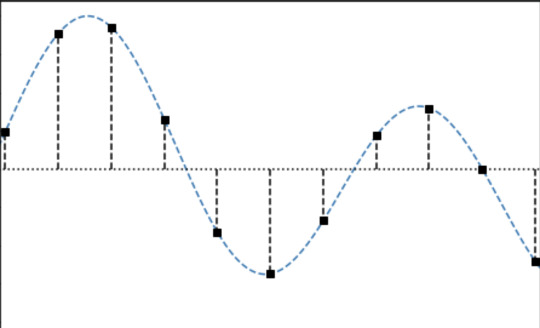
You can imagine the smooth curvy line as an analog recording. No gaps. No information loss.
The black squares are digital samples recorded over a period of time. You can see there are gaps between those black squares. A tiny bit of time passes between the squares where nothing is sampled. INFORMATION LOSS! NOOOOO!
Clearly the vinyl nerds are correct and digital is inferior, right? You are going to get the dreaded... STAIR STEPS!
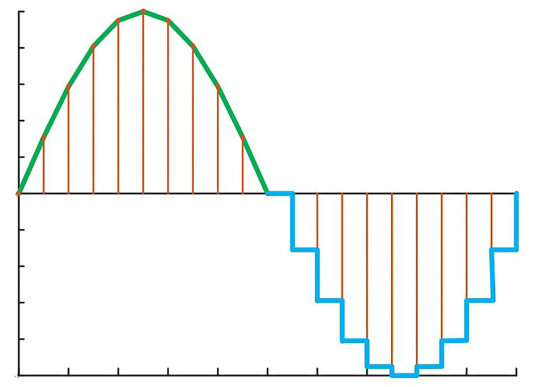
Not so fast, bucko!
By getting enough samples over a period of time, you can use math to infer that smooth sloping line connecting those individual samples. So the digital recording also has no information lost once it is converted back to analog and played through your speakers.
This connecting of dots is called "interpolation."
You could take the curvy analog, convert it to digital, get the same black squares, and then interpolate the black squares back into analog and get the same curvy line. It goes back and forth perfectly. And this is all verifiable with an oscilloscope.
NEAT!
Then of course you need a good dynamic range--the spectrum of quiet to loud. Anything above 85 decibels will damage your hearing, so they went with a 16-bit depth which covers roughly 100 dB. Again, giving them a little overhead for death metal and overzealous trumpet players.
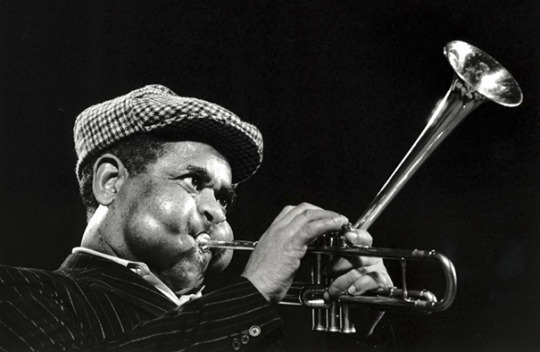
And the final component is data bandwidth or "bitrate" usually measured in kilobits per second. This is how much data is read every second. The 1s and 0s of it all. The bitrate of a CD is calculated by multiplying 44,100 samples per second per channel by 16 bits per sample and then multiplying by 2 channels. After all that mathing is math'd, you get a perfectly uncompressed 1,411 kbps.
So you've got all the frequencies you could ever hear combined with as much volume as your ears can stand with a bit rate that will give you no loss of data.
The *perfect* audio quality all encoded into little microscopic pits.
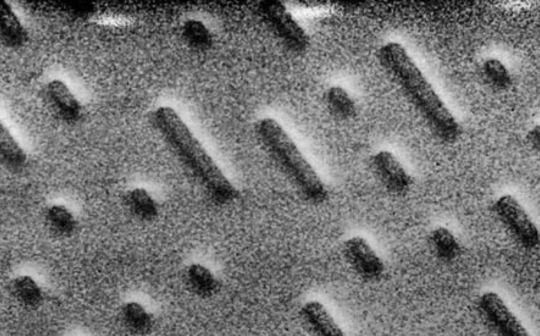
Now you may be asking, "Why do I see "24/96" or "24/192" advertised on fancy audio equipment and high quality streaming platforms like Tidal? Aren't 24 bits better? Isn't 96 kHz MORE than 44.1 kHz?"

Dr. Nyquist might say... this is some bullshit.
This confusion comes from the fact that recording quality and playback quality are two different animals. This misunderstanding happens with video and photo quality as well. Recording in 6K will give you a sharper picture even if your final playback quality is 4K. You can get bad pixels and noise and stray photons that do not contribute to the detail in the video. By giving yourself overhead you can ensure you hit the desired quality target.
And recording at 24 bits and 96 or 192 kHz, you get a higher resolution to edit and master with, but it is only advantageous to the computer software... not the human ear.
From a photographer's perspective, I relate to it like this...
If I have more megapixels and more colors and more dynamic range I have more leeway when editing my photos. If you try to push a low quality photo in the edit, it has this tendency to fall apart. You can get ugly color banding and harsh contrast and sharpening artifacts. By capturing more quality than you need in the finished product, you can process the photo much more dramatically before it deteriorates and loses integrity.
Audio and video are the same way.
So let's say you have a metal singer that screams at the microphone as loud as possible from 2 inches away.
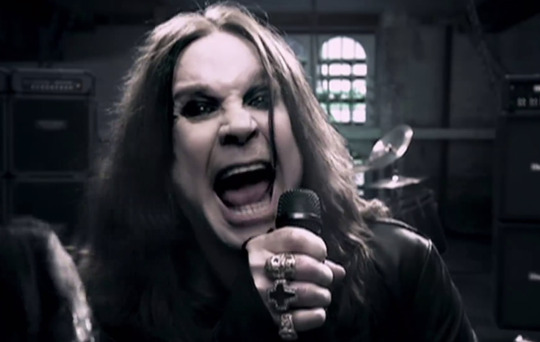
At 16 bits they may surpass that 100 decibel dynamic range and distort the recording. But if you record in 24 bits, you get 144 dB to play with. Or you can even do 32 bits and get 1500 dB--a volume that no human voice could ever surpass. It guarantees a clean, distortion free recording, but 32 bits would be pointless for human listening.
The same is true with the sample rate. Having a higher resolution allows you to zoom into waveforms and adjust things to an extremely granular level. You can do precise timings, tiny pitch adjustments, apply loads of digital effects, and just have more room for audio activities without degrading the sound quality.
But outputting 192,000 of those black squares is going to interpolate the exact same smooth curvy line as 44,100 when it is played through speakers.
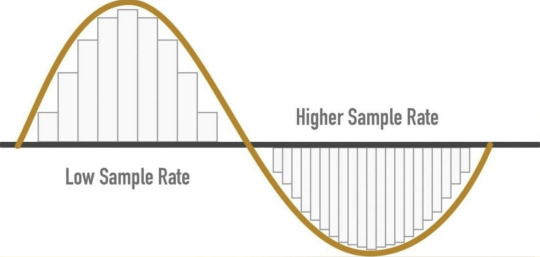
The oscilloscope knows what I'm talking about.
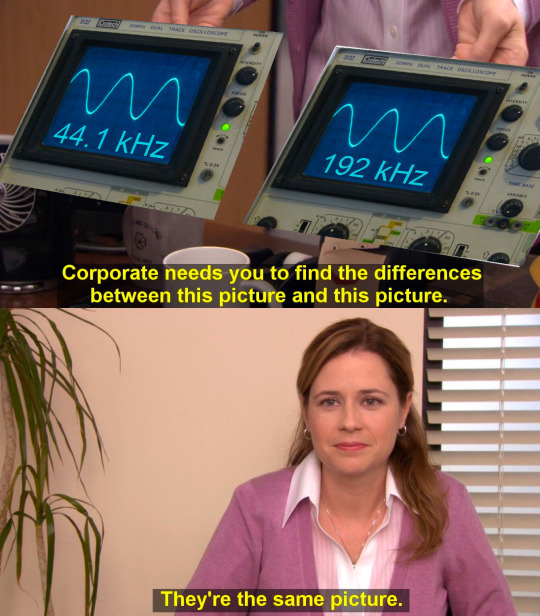
Now I am about to reveal a secret that no audiophile who has invested in a $115,000 high resolution 32 bit/3,072 kHz DAC wants to acknowledge...
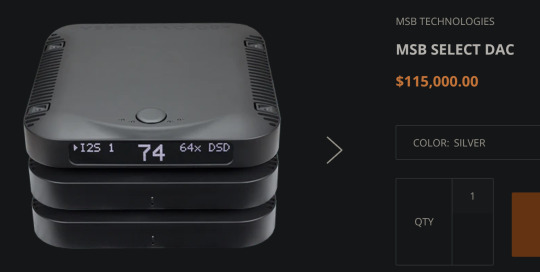
The master recording is always more important than the playback quality.
If you have a high quality source it will sound great even in a highly compressed MP3. Just like the 6K video is sharper on the 4K TV. And the high megapixel photo looks better in an Instagram post.
If the source is good, the media will be good.
And since high resolution audio services often seek out the best masters available before encoding their playback files, it gives many people the illusion they are getting better sound quality due to the boosted specs.
When in reality, it was just a better copy of the original recording.
According to Nyquist, your human ears are not computers and all you need is double the frequency to hear perfect sound with no loss of information. So anything above 16 bit/44.1 kHz/1411 kbps and you are just wasting bandwidth on a server.
And I don't want to hear anything about "stair stepping."
IT'S MATH.
Your ears aren't better than math, okay?
If you don't believe in math, then you and Jack White can sit in the naughty math corner with his bespoke overpriced vinyl pressings.

I will say, there is a gap between your standard music streaming service like Spotify and your bullshit audiophile service like Tidal.
Free Spotify uses heavily compressed files. Which means the bitrate is quite low and there can be information loss. Or "lossy" compression. Modern compression is actually pretty amazing, but I'm afraid anything below 320 kbps may cause some songs to not sound as intended.
Depending on the content, some songs are more suited to compression than others. And even with premium Spotify, they cap songs at 320 kbps which still may not be enough for busier, harder-to-compress songs.
Also, I don't know if Spotify cares about getting the best quality master for a given song. Which, again, is the most important aspect of sound quality.
But services like Tidal waste bandwidth with their super specs and that isn't great for the environment. What I'd love to see is a company that makes their best effort to seek out high quality masters, and encodes their files at 16 bit/44 kHz with a lossless variable bit rate compression. Variable bit rate or "VBR" will do more compression during simpler parts of the audio and less compression during more complex parts. It's smart compression, basically. And as long as you use a high enough bitrate to achieve lossless compression, the sound quality will be the same as if there is no compression at all. So you still get smaller file sizes that use less bandwidth and have a smaller environmental impact.
That would be a streaming service I would consider paying for. Especially if they put great effort into getting high quality original recordings for their content.
In conclusion... if you are still using CDs you don't need to worry about audio quality. You're all set. There is a sort of beauty in what the audio scientists who created compact discs did. They figured out the limits of human audio perception and created a format that just slightly exceeded that. No "bigger number is better" marketing. No audiophile bullshit.
They said, "Here is what you need and nothing more."
They made a perfect thing and they should be proud of that.

435 notes
·
View notes
Text
this winding labyrinth, chapter 12
chapter twelve: consumption
pairing: Hannibal Lecter/Reader (reader's race & gender are ambiguous; no physical descriptors or pronouns are used)
summary:
You wish you never met Hannibal Lecter. But you yearn for his presence. You want to forget him. But he never truly leaves your thoughts. Now, you’re left to pick up the pieces of a broken design. A battle of instinct rages on in your mind—one of bittersweet relief and cloying grief, fearless resolve and poignant regret; a clashing between affection and antipathy, pride and pain. What will win, in the end? Only time will tell.
this is chapter 12, act 2 of this broken design. if you haven't read act 1 or chapters 1-11, this won't make too much sense.
ao3 version | Spotify playlist

warnings: typical violence, gore, blood, cannibalism, self-deprecating thoughts

Your dreams have only grown more convoluted and inexplicable since Frederick Chilton’s death. First dominated by somber blues interspersed with the unmistakable crimson stained across your skin, your nightmares now carry familiar yellow-grey tints. You are often haunted by the sound of wings swiftly beating in the air; harsh, warm breaths hitting your neck and sending shivers down your spine; and the dull burn of midday sunlight.
Reportedly, William Blake—the artist who created The Great Red Dragon and the Woman Clothed with the Sun—was under-appreciated throughout his life. Only the onset of the Romantic Age brought suitable attention to his works, both written and visual. There is nothing about Blake that strikes you as particularly relevant to the killer’s violent tendencies. It seems that his obsessive attention only lies with the painting itself: with broad shoulders supporting swooping wings and pale hands clasped in fervent emotion. Further research informs you that, despite Blake’s known skepticism and scrutiny of religion, The Great Red Dragon and the Woman Clothed with the Sun was situated in a series of paintings intended to depict scenes from the Bible. You can’t necessarily see the killer as a devout or pious person, but he certainly seems to treat the painting with a sense of reverence.
Your conversation with Hannibal weighs on your mind, as your discussions with him often do. You can’t help but think that his phrasing was entirely intentional—and that the term ‘consumption’ is indicative of more than a mere transformation. Jack seems to think the same. When the two of you track down the painting’s physical location at the Brooklyn Museum in New York, you finally start to feel as if you have a lead.
It’s roughly a six hour drive to the museum. You spend the time focused on the road, while occasionally switching radio stations when the music starts to bore you. At some point, Jack calls you to ensure your travel is going well—and the two of you review your next course of action. Finally, after what feels like far too long, you’re situated in a cramped parking lot behind the museum. You’re immediately grateful that Jack called ahead and spoke to lead officials at the museum, thereby ensuring your visit would be unhindered by administrative red tape. You pay a glance at the clock: it’s 8:27 p.m. The museum closed to the public nearly two and a half hours ago. You stall in the car for a few moments before heading up the steps, pretending to feel calm despite the steady thrumming of your adrenaline.
Jack and you don’t expect much direct evidence to come from this visit, aside from visitor data that the BAU can comb over and scrutinize. As time has passed, you’ve narrowed in on several key traits of the killer’s… which will certainly eliminate some people. Then again, the museum likely only tracks voluntary disclosures of information. The visitor database likely only has gender, age, marital status, and any past visits or contributions. Still, it could be a start.
Admittedly, there’s another component to this site visit. Jack and you have struggled to pin down the killer’s relationship to the painting. An in-person visit will allow you to get a better look at the painting. As you finally make it up the steps and towards the accessible door where you’re directed to enter, Hannibal’s voice rings in your ears. Consumption. Becoming. His true self will be eradicated upon completion of the process. Is there any chance the killer has visited this museum to get a look at the painting? Did he ever stand frozen in front of it, a silent and strangely foreboding figure quietly warding off other visitors from its magnificence? Did he ever walk down these halls with a visceral purpose?
Your concentration is broken by the telltale jangle of keys. Filing those thoughts away for later, you approach the front desk and show them your FBI badge—explaining that you have a brief meeting with one of the curators of the museum. They nod and turn their back on you for a moment, mumbling something into their walkie talkie before sighing.
“I’ll go fetch her,” the receptionist promises, resignedly glancing down the hall towards the escalators. “Shouldn’t be too long.”
You thank them and wait with bated breath. Three minutes… four minutes… Five minutes… The time drags on with a painful clumsiness. After ten minutes, you begin to pace restlessly. You’re skeptical of why they’re taking so long—it’s after hours, which means there shouldn’t be any other distractions in the building. Are the archives far away? A million different explanations run through your mind, each more unreasonable than the last.
Finally, after what feels like an hour, the receptionist returns with the curator in tow. She introduces herself and you’re quick to shake her hand, unable to hide your relief. Your thoughts were quickly spiraling into fantastical territory, as you dreaded several different dangers that could’ve prevented her from arriving. But the curator is calm and collected, pushing her glasses up her nose and staring at you with gleaming brown eyes. Her hair falls in elegant dark brown locs that frame her face beautifully; she wears a pale lavender blazer with a pencil skirt and loafers. You immediately feel self-conscious of your rather plain attire. The FBI has always been stringent on uniform requirements, especially when it comes to working in the field. The most you can get away with is a mildly patterned dress shirt and slacks. The curator’s warm brown skin is entirely void of scars or marks—unlike yours, you think self-consciously. The scar on your left eye seems to draw a lot of attention, as people often ask you how you got it. You feel a brief and unfamiliar stab of envy before you refocus your thoughts.
If the curator senses your insecurity she is kind enough to ignore it—instead offering a handshake. “I’m Evelyn, one of the Collections Curators here.” You shake her hand and introduce yourself in return. Evelyn is quick to lead you down the hall towards the escalators with a practiced ease. Feeling a strange urge to make conversation, you ask her how long she’s been working at the museum. Through your unexpectedly long walk across the second floor and through several winding halls, you learn a bit more about her: she’s been working at the museum for almost eight years now; she studied anthropology in school and went back for her graduate degree in museum studies, with concentrations in art history and writing; and she is particularly interested in art stemming from the Romantic period.
You always feel a strange mix of contentedness and self-doubt when speaking to other people around your age. The FBI has dominated your life for so long that it’s hard for you to imagine a time when you weren’t pursuing criminals and investigating crime scenes. And while that may sound exciting to many, the life of an agent like yourself is heavily romanticized. Not to mention, such work can easily bleed into all aspects of your life. The past few years have been especially difficult for you when it comes to maintaining your work-life boundaries—they’re practically nonexistent now. Conversations like these ones—innocuous, harmless—remind you of the life you could’ve had. It’s bittersweet.
You finally manage to focus on the task at hand, as Evelyn stops in the middle of a room lined with counters, drawers, and shelves as far as the eye can see. She explains that you’re currently standing in one of the museum’s many storerooms, where they keep items that are not on exhibition. It seems Jack briefed the curator a little, because she already knows which painting you’re looking for. There’s a sparkle of curiosity in her eyes, but it’s quickly suppressed with an admirable professionalism. Her gaze flits to your badge, hanging from your right pocket, before she’s asking you what you’ll need for investigation. Evelyn proves to be extremely helpful, as she gives you the contact information of the Audience Services Manager who can give you access to the visitor database. In terms of the painting itself, she gives you a quick overview of the process: she’ll go into the back room and retrieve the work; when she returns, you’re allowed to look at it but not touch it.
"The Great Red Dragon and the Woman Clothed with the Sun is extremely sensitive to light, so it’s kept hidden away in that storage room,” she explains. You follow her gaze to find a steel door and a black badge scanner next to it. Evelyn leaves you with the promise that she’ll return shortly. You’re left to your thoughts, which are quickly returning to the unpleasant spiral they were before. You restlessly pace up and down the aisle of the storage room, your hands shoved in your pockets and your mind running a mile a minute.
After a while, you glance down at your watch. It’s been ten minutes. You’re growing worried. After a few more minutes spent in deliberation, you decide to look around the room for a neglected employee badge to get you into that room. Suddenly, time seems to be speeding away from you; you’re only growing more panicked as you throw open drawers that definitely shouldn’t be touched. After several minutes, you finally find a badge and nearly sigh in relief.
Scanning the badge opens the door with a devastatingly loud buzzing noise. You enter the room to find the space dimly lit, complete with glass casings and rows of shelves that nearly extend out of sight. The shelves are mobile, you realize upon closer inspection. Cranking the hand crank at the end of the room will push them aside. Frowning, you take a few more cautious steps into the room—until you see a pair of black loafers, just barely visible between the sprawling shelves. Heart racing, you listen for another presence before silently making your way over. When you finally reach the partition, you find Evelyn sprawled across the ground. There’s no visible sign of blood, but you still quickly crouch down to feel for a pulse. Her heart rate is a bit slow, but otherwise present. You take a slow breath and remain frozen before her for several more moments, ensuring the assailant isn’t in the room. Then you grab your phone from your pocket and quickly input the five digit number that acts as a distress signal, alerting Jack and the nearby authorities. After listening for disturbances again, you manage to pull Evelyn off to the side and shelter her behind one of the desks. With any luck, the assailant will be too distracted with you to notice her.
You have a gut feeling the assailant is the same killer you’re searching for. But your suspicions aren’t confirmed until you hear a violent tearing sound, as if something is being ripped in half. You glance across the room and hear another shredding sound; immediately, you quietly move to hide between two of the shelves. Evelyn hadn’t told you where the painting’s exact location was, but you don’t think you need it. You’re certain the killer—the Dragon, as he fashions himself—is here in this very room. Moreover, it seems as if he’s currently ripping the painting into small pieces.
Now, though, there’s a haunting silence. You lean closer to the shelf in front of you, only to hear nothing. You’re not sure how long you remain there before you hear the slightest inhale and a sound that sounds weirdly similar to chewing. Lightning searing through you, you start to connect everything together. Consumption. Hannibal was referring to it in the literal sense, after all. The killer is consuming the painting to make himself one with it.
Right about now is when you would surge forward and point your gun at the killer, successfully apprehending him. But you only have a knife. After all, this wasn’t supposed to be anything more than a mere conversation with the curator. Jack and you never thought the killer would actually show up—and at the same time as your visit, no less. Besides, you figured you may not make a great first impression with the museum curator by carrying a visible weapon around in the building. You regret that notion now, of course. But it’s too late for regret.
In your musing, it seems the killer has finished chewing and swallowing the painting. You suppress a shudder at the thought of eating the canvas: the dry, starchy material sticking to the roof of your mouth; the wet lump traveling down your throat. It sounds revolting.
Of course, you don’t have time to contemplate the thought, as you realize the killer’s footsteps are sounding far nearer than before. There’s a brief pause and you inch your way towards the mouth of the shelves.
There’s an ominous creak and your heart drops to your stomach as you realize the shelf in front of you is slowly inching its way towards you. The killer is rearranging the shelves—likely returning them to what they were before he took the painting. But now you’re stuck in an aisle as the shelves move to close you in. Thankfully, they move rather loudly; still, you place a hand over your mouth to stifle your quick breaths and quietly inch out of the rapidly shrinking space. By some miracle, you manage to make it out before you’re completely crushed.
Unfortunately, this places you right within the killer’s line of sight. He’s wearing some sort of covering that obscures the lower half of his face, but you can still see the moment his eyes find yours. He lurches forward in a surprising bout of speed, knocking you to the ground before you can grab your knife.
You’re immediately forced to reckon with one realization: you’re not fighting a man. You’re fighting a beast. He does not brandish a weapon threateningly or engage in swift hand-to-hand combat. Instead he bites and thrashes; writhes and yanks at anything within reach. His fingernails are long and sharp, and they break the skin of your arms as you try to shove him off of you. You’ve had extensive combat training to prepare you for virtually any kind of situation. But when it comes to a fight like this—purely physical and fueled with adrenaline—you feel woefully unprepared and outmatched.
Your knife is concealed in your belt, but the guy’s hands latch around your throat and squeeze with a truly frightening strength. Your vision immediately stutters as spots flash across the room. A roaring sound floods through your ears; you try to wrench his grip off, but he’s shifting his weight forward—and it feels as if he’s shoving you through the floor. The world is pulsing around you as you try in vain to reach for your knife. You fumble it out of your pocket as your vision threatens to fall to black; you manage to stab him in the side and his grip fumbles long enough for you to escape.
You immediately push yourself to your knees and brace yourself against the ground, heaving and rasping as you finally get the air you were fighting for. Nausea burns in your throat and saliva falls from your lips as you regain control. You hear a sickening squelch and a harsh clang; you look up to find the killer stepping on your blood-slicked knife and kicking it across the floor, sending it skittering away from you.
It’s as if he isn’t even wounded. He’s descending on you with the same ferocity as before, panting like a predator salivating for its prey. At this point, you’re attempting to get away from him—only for him to harshly grab your collar and slam you into the ground. Your head rattles and throbs; blood falls from your nose and down past your lips. The killer harshly flips you around until you’re on your back, dizzily looking up at him. Then he dips his head down dangerously close to your neck and bites. You scream and try to shove him off of you, only for him to rise moments later with a bloodied chunk of flesh between his teeth. Your stomach rolls in disgust and there’s a violent buzzing sound echoing in your ears. Through sheer panic and bone-deep fear, you grapple with the man long enough to get him off of you. Something flashes in his eyes mere moments before you harshly knee him in the gut. It gets him off of you, leaving you just barely enough time to scramble for the discarded knife. You make a mad grab for it, expecting to be harshly dragged back by the ankle. Instead, you face no resistance. But, once you reach the knife, he’s already out of the room.
Swearing, you stumble after him—but the guy is fast. You run down the hall as quickly as you can, only to look around and find no sign of him anywhere. You look along the floor for a trail of blood or a wayward footprint, but there’s nothing. It’s as if he was never here in the first place. You grip your knife tightly, attempting to breathe normally despite the overwhelming tightness in your throat, pulsing in your chest, and throbbing in your temple.
Your adrenaline is swiftly falling, even with the knowledge that the killer could still be lurking around any corner. You press a shaking hand to the edge of your neck; it comes back dripping with blood. Something like a whimper escapes your lips as you promptly topple over, just barely catching yourself from a nasty collision with the ground. Try as you might, you can’t seem to get yourself back up—and you’re giving into the shadows creeping across your vision without much of a fight.
______
You wake up in a hospital.
Your first instinct is to groan—and you attempt to do just that, but the muscles in your throat constrict and you choke on a breath instead. Immediately, there’s a hand on your shoulder and a patient voice admonishing you for the effort. The nurse gives you a brief summary of your condition, explaining that you’ve been unconscious for a few days. You’ve suffered a moderate strain to your vocal cords after the killer’s attempted strangulation, which explains your current inability to speak. You’re told that this will pass in time, as long as you take it easy. You also have a mild concussion, but that’s pretty standard fare for you.
There’s a dull ache running through your limbs as you summon the energy to push yourself out of the bed and head for the bathroom. You just barely catch a glimpse of your reflection in the mirror, but it’s enough to send a renewed wave of fear and disgust running through you. Your neck is mottled with bruises, an unsightly mix of vivid purple and blue. You nearly look like a walking corpse. Tears threaten to spill from your eyes as you reach for the spot where the killer bit you, only to find a bandage hiding the damage. You stare at your reflection defeatedly for a while, before eventually convincing yourself to return to bed. It’s clear your stamina has been affected, because even standing still for a few minutes is enough to make you fatigued. You blink and lean back into the pillow behind you. Despite the dull thrumming pain that seems to run across your entire body, you fall asleep within moments.
For a few more days, your life is only defined by sleep. You sleep, wake up, go to the bathroom, and go back to sleep. It’s a vicious cycle—one that very nearly convinces you of your uselessness—but you manage to remain bedridden for the duration of your stay. The damage to your neck and throat is something you haven’t experienced before, and you don’t want to jeopardize the healing process.
Unfortunately, this means you’re at the hospital for more than a week. As you slowly heal, you find yourself assaulted with an immense desire for company. Beverly visited you nearly every other time you were incapacitated; but you’re nearly six hours from Quantico now. And besides, you haven’t exactly been a great friend to her lately. You’ve been too absorbed in your own affairs to offer her support or spend much time with her. No, this hospital visit is different: you don’t see Beverly or Jack. (Or Hannibal, a traitorous voice reminds you, summoning memories of a soup garnished with your own kidney and a kind smile that seemed strangely genuine.)
You do, however, have an unexpected visitor. Evelyn enters your room one morning, a sympathetic smile rising on her face when she sees you. “Hey,” the curator says. There are slight dark circles under her eyes, but otherwise she looks healthy. You feel a smile rising on your lips in response, happy to see she’s looking well. “How are you feeling?”
You tap your throat and she grimaces, evidently getting the message. Then you reach over to the nightstand and show her the notepad and pen the nurses gave you. She nods and takes a seat at your bedside, patiently waiting for your response. Your penmanship is slightly shaky, but you manage to get it down with relative ease: You shouldn’t be here. I almost got you killed.
She frowns. “Don’t say that,” she admonishes you gently. “You couldn’t have known that would happen. Besides, you fought him off. Who knows what he would’ve done otherwise.” She shakes her head in disbelief.
You meet her eyes and feel your throat begin to burn. There’s such an intense longing building in your chest and you can’t quite pinpoint what that desire is meant for. Friendship? Companionship? A normal life? A stable career, without the emotional turmoil and survivor’s guilt? A face unmarred by killer’s knives?
You swallow past all those feelings and manage an unsteady smile. Evelyn doesn’t deserve any of this—you will not dump all of these thoughts on her. She doesn’t deserve your emotional baggage. What she deserves is a return to her normal life—and a departure from you. It would be best for Evelyn if you never saw her again.
But she is incredibly compassionate, and promptly refuses to award you any blame. She sits by your side for almost an hour, having a virtually one-sided conversation while you write out your responses. Evelyn’s kindness only reminds you of just why you first entered the academy. You wanted to protect people like her. Not that they couldn’t protect themselves; rather, you wanted to ensure they never had the need to do so.
And look where that got you, Frederick Chilton whispers to you mockingly. You should have stayed away.
You ruin everything you touch and everyone you meet, Abel Gideon laughs. You should have stayed away.
Away, Garret Jacob Hobbs says, his voice slowly blending with Clark Ingram’s in a terrifying tone, away away away away away—
Evelyn’s voice breaks you from your thoughts; she’s getting up from her seat, and you can’t decide whether you should be relieved or dejected. She does write you a quick note, with her phone number and a wholesome ‘Get well soon!’ message with a smiley face drawn next to it. She also gives you a hug before she leaves; your eyes burn as you reciprocate it, desperate for comfort even though you don’t deserve it. You save her number in your phone, despite knowing you’ll never contact her. It doesn't matter how much you may want to speak with her. You will never pluck up the courage to separate yourself from the unquestionable knowledge that you brought a killer to her doorstep. She survived your life once—you will not make her do that again.
It’s not the first time you’ll distance yourself from someone because of your work, and you know it likely won’t be the last. It hurts all the same. You rub at your eyes tiredly, a sudden exhaustion pressing you into the stiff mattress and forcing your eyelids shut. You quickly find yourself a victim of those confusing, unsettling dreams of yellows and greys once more.

next chapter

thanks for reading! <3
check out my other works, sorted by fandom.
friendly reminder that i don't give permission for my writing to be shared to other sites, stolen, copied, translated, or used in any way. thanks!
hannibal taglist: @its-ares @tobbotobbs @xrisdoesntexist @gr1mmac3 @tiredstarcerberuslamb @yourlocalratwriter @kingkoku @kahuunknown @atlas-king1 @pendragon-writes @slipknotcentury @cryinersaved @the-ultimate-librarian @starre-eyes @pendragon-writes @peterparkeeperer @gayschlatt69 @flow33didontsmoke @mrgatotortuga @house-of-1000-corpses-fan @faggotboulevard
#defectivevillain#hannibal lecter#hannibal nbc#hannibal x reader#hannibal x gn reader#hannibal x male reader#Hannibal Lecter x reader#transmasc reader#gn reader#male reader
44 notes
·
View notes
Text
2024 Spain Grand Prix Race Analysis
Table of Contents Ferrari - Upgrades - Charles VS Carlos - Footage Analysis - Data Analysis Red Bull - Max - Sergio Mclaren - Lando Other Moments and Drivers of NoteFinal Thoughts
This analysis is going to be shorter and more focused than usual. I am mostly covering Ferrari here(this is a Ferrari blog that is my primary focus) as well as the main things of note in the race. This race wasn’t as revealing as I expected it to be. I think there is a lot left in Mercedes and Ferrari as far as performance goes. Will be looking at the relevant data for all top teams and drivers as that was interesting this race.

Ferrari
Upgrades
Ferrari upgraded a few components on the SF-24 for this race weekend. Many have been disappointed with the results. However the team have said the data they saw reflect what they expected from the parts, and that the lack of competitive pace came down to the specific car setup and failing to get the cars in the right window. It will likely take a few races for the team to dial in these new upgrades to get better performance.
I don't think rushing the upgrades is the reason the results weren't good. That wasn't the issue either.
We should see more potential of these upgrades in the next few races. Just keep in mind that because the results were not stellar this weekend does not mean the upgrades were bad or have not added any pace. The team have said they need a few races, so we will wait to see how the next few races unfold. The data does show that the SF-24 still has competitive race pace. We know this car can also qualify well. However I think the problem is that the operating window for good qualifying is quite narrow and getting it right is much harder. That is an area the team needs to hone in on. This is also tricky as with upgrades this window changes.
The data does suggest that if the SF-24 starts high in the field the car has the pace to compete seriously at the front for podiums.
We should see better performances from the car in the coming races. The team have a plan for the direction they want to take things. One thing we have learned that the qualifying pace in the SF-24 is there, the car can qualify on the front row, it can take pole, but the operating window for it in qualifying is quite narrow and it's easy to miss. This is certainly something that the team must address. With each race they are getting better at working with the drivers on this.
The Race
Ferrari’s race was largely uneventful. Charles qualified P5 and finished P5. Carlos qualified P6 and finished P6. You would think there isn't a lot to talk about for their races, and yet-
There are a few moments in Ferrari's race that have sparked debate, and been the subject of a lot of analysis and criticism. I am going to cover the race strategy in detail and debunk some of the misinformation that has been spreading about the way this race was handled.
Charles VS Carlos
There are two parts of the race between both drivers that I want to cover in detail. The first is Carlos' pass on Charles on lap 3, and the second is the swap between during the final stint.
Lap 3 Pass
I first want to point out Ferrari’s strategy for stint one on the softs before we get into the actual pass. The strategy was to start on the new softs, preserve them at the beginning of the stint, and attack Mercedes when their tyres started to fall off. Mercedes were starting the race on used softs, so Ferrari’s plan was to manage on the new softs until Mercedes slowed due to deg and then Charles and Carlos would be able to push because they were on newer rubber and would have the pace to be able to easily pass. This was a good idea to potentially get both cars ahead of at least one Mercedes, and there is a good chance it would have worked.
Ferrari have confirmed that this was the strategy for stint one that both drivers were informed about was to slowly warm the softs on the opening laps and attack later in the stint when the Mercedes were vulnerable.
That was the plan.
What happened was a little different.
At the beginning of lap 3 Carlos passed Charles going into turn 1. He made slight contact with Charles and pushed him off the track to make the pass.
This was an unnecessary and risky pass from Carlos. It accomplished nothing and made Ferrari’s race more complex than needed. The move wasn’t legal. Carlos also did not have faster pace to justify taking the position. He also did not follow the team strategy agreed upon before the race.
I think that this incident traces back to what the drivers mentioned in their post-race interviews regarding first stint strategy.
There was clearly a disconnect between Charles and Carlos about how to manage the first stint. Carlos claimed he was managing better and that he was stuck behind Charles who was managing too much. Okay, well he pushed on lap 2 to overtake Charles, and Carlos said that 1. He was managing better and 2. That since they were on new softs compared to the Mercedes they needed to attack. Well, we can see in the data that the pace he claimed was faster wasn’t sustainable, and that he fell back to the exact same pace as Charles after the overtake. Carlos also could not have known after a single lap the pace Charles was setting. The tyres weren’t even fully warmed up, yet he acted like he was stuck behind a slower car for laps on end. It was 1 lap and Charles wasn’t slower, their pace on the first stint of softs was identical at the start(until Carlos lost pace and had to pit). And second, Carlos said the plan was to use the softs to attack early. Fair enough, but all he did was push to pass Charles. After that he fell back to setting that same pace preserving tyres. He didn’t push to try to catch either of the Mercedes. And the pace he set on lap two was certainly not a tyre saving pace and wasn’t sustainable. So all he did was pass his teammate, which accomplished nothing for the team.
Charles claimed that the plan was to save tyres on that first soft stint to be able to catch Mercedes at the end. His driving suggests this was the plan. Immediately he felt out the exact pace for that tyre preservation, evidenced by the fact his softs lasted 9 laps longer than Carlos’.
Carlos “attacked” and used the pace of the new rubber at the wrong time. He didn’t want to get past Mercedes, because that wasn’t possible at that point in the race. He wanted to get past Charles. It was unnecessary, and was not good strategy on his part. The optimal time to “attack” would have been near the end of the stint, the team would have relayed data about the pace of the Mercedes and helped both Charles and Carlos time the moment to push.
Carlos pushing then cost him the ability to do so later in the stint. It cost Charles as he had to fight his teammate during that lap. And it compromised Ferrari’s plan to have both cars attack near the end of the stint. Carlos ended his own race on lap 3 with that move. There was no strategic advantage, he wasn’t faster, and he didn’t make any gains on an actual rival team.
Charles who managed his tyres better that whole stint was stuck needing to catch and pass Carlos instead of being able to push to get by George. Carlos was unable to push as much at the end of the stint because he pushed so much at the beginning. This is how Carlos compromised Charles' and Ferrari’s race, and thus his own.
At the very least this likely cost Charles a place. We cannot know for sure, that would have been a valuable place gained.
Furthermore, the contact between the two cars was small. It seems there was no significant damage to Charles' car, at most there was damage to a winglet on his front wing. But anything can matter, and the risk of contact between the cars could have been much greater. The data does not indicate Charles lost any meaningful pace due to this contact.

Here is both driver's first full stint on the softs. They were on an identical pace with no real difference those first 12 laps, save for lap 3 when Carlos sped up to make the pass. He argued Charles was going too slow and managing too much but we can see here that the management pace that Charles set on lap two was right in line with the pace that Carlos himself set the rest of the stint, so the pace was not too slow for management and in fact was exactly what both cars should have been doing. You can also see how much longer Charles was able to make those softs last without losing any performance. Charles was managing best on the softs.
We can debate on whether or not Carlos should have made the pass as much as we like. But let’s look at the real problem here, that the pass itself was also in a gray area of legality. Carlos turned into Charles, he was the reason for the contact, and then he didn’t even stay on the track after making the pass. So the point on if he should have done it is moot because the pass itself was likely illegal.
Carlos himself also seems to be of the opinion that this kind of move was not legal, as when Lewis and he made contact in a very similar way later in the race he made it quite clear he thought that was penalty worthy from Lewis(the car making the pass) So, even if the move fell under “hard racing” Carlos himself seems to think that such things are deserving of a penalty.
Lap 3 Footage Analysis
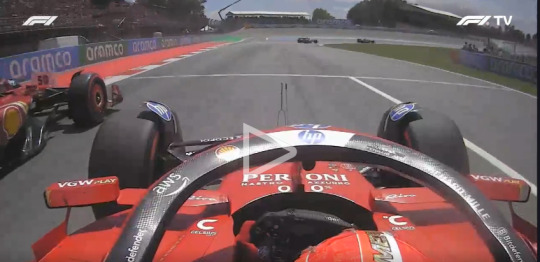
Carlos has the outside line, he's pulled up alongside Charles for the pass.

Carlos is cutting in a straight line across the apex of the turn, forcing Charles off the track. Note here that Charles is turning his wheel away from Carlos trying to avoid contact.

This was the moment contact was made. The tyres tapped. The important thing to note is that Charles has been forced off the track almost completely for Carlos to make that pass. And also note that Charles is still turning severely

After this Carlos lost control and has to use the runoff after making the move.


More shots of the move to confirm the car placements. The main thing here is that Carlos forced Charles off the track and then wasn't able to stay on the track after making the move.
Note that using the runoff area after making a pass is legal.
This was a bad pass, just from a racing standpoint. He needed to force the other car off and make contact to make the pass and then couldn't keep control of his own car after making the pass.
Charles did what he was supposed to. Carlos even had room to make the pass cleanly. Instead he turned all the way into the corner forcing Charles off. And if he wanted to take the apex better he should have sped up more, if he was unable to do so then he didn’t have the pace to make a clean pass.
Again this was a risky pass, it was unnecessary and risked both cars, for no real gains. This move also cost Carlos on his own tyre condition.
Why didn’t Carlos get a penalty for that then? Well Ferrari would have to advocate for it, and they’d be going against their own driver. As bad as this was, we do not want a driver taking a 5 or 10 second penalty for that, that is also bad for the team. The move wasn’t so outwardly egregious that the stewards were going to give a penalty without a team pushing for it. So it was only going to result in a penalty if Ferrari pushed for it and they were not going to do that. And it would not have been wise to do so.
Also I would say this still falls into a gray area, simply because Charles has the edge of one tyre on track and the contact was very minor. There is an argument to be made this falls under hard racing. If it were not teammates I would agree. I think that this was a step too far between cars on the same team.
It was poor racing on Carlos part, bad estimation of the turn, bad pace estimation, bad tyre management.
Charles moved out of the way, he turned further away from Carlos even when he was almost completely off the track in an attempt to avoid contact. He did what he was supposed to do, Carlos had the space to make the pass, if he indeed had the speed to do so.
Lap 55 Pass
So now let's move on to the second moment of note in Ferrari's race. To understand the lap 55 pass I need to explain Carlos' tyre strategy from this point onward.
Carlos had to pit lap 37 after his medium stint. He needed to go on hard to be able to finish the race without doing 3 stops. It has been claimed that Ferrari screwed Carlos over by putting him on hards when softs or mediums were available. But there were 66 laps. Carlos was only able to make softs last 15 laps, and able to make mediums last 19 laps. The only way he was going to be able to finish the race without doing 3 pit stops was if he took the hards. He simply was not managing his tyres well enough to make a softer compound last the remaining laps. A 3 pit strategy would have also been worse for him, he would have lost more time and the risk of losing more positions was too great.
This was the best pit and tyre strategy for Carlos given his performance and tyre management this race. Ferrari supported him with a strategy that got the best outcome possible for him given the way he was managing tyres.
Charles made his first softs last 24 laps, and his mediums lasted 21 laps. This put him in a window to be able to use the final set of softs Ferrari had without being at a serious risk for a drop off in performance. To get to use the soft effectively in the final stint that required Charles to make the softs and the mediums last as long as possible. He did that and that is why he was in that window for the final stint.
Carlos wasn’t left to languish on hard tyres. That was the only way he was finishing without having to pit three times. If he wanted to be able to do a soft stint at the end he needed to manage his first set of softs better and also get more life out of the mediums.
Carlos of course can feel however he wants to feel about that, I understand the frustration of being on a slower compound. But there was no strategic reason to put him on the softs.
On lap 55 Charles passed Carlos. He did so after he pit for softs and climbed back up to Carlos. Since he was on softs he was significantly faster and Ferrari gave the team order for Carlos to let Charles pass. Carlos was on hards, much slower, the slower car should not slow down the car on fresher faster tyres. We saw the exact same thing in Japan when Carlos came up behind Charles and he was on newer tyres and Charles let him pass. This is a very standard strategy call.
There were 11 laps left in the race. Having Carlos hold Charles up made no sense. Charles had softs and he had at least a chance to try to catch George. Carlos was not on the tyre strategy to make up places at this point. His strategy was to hold position and keep others from following Charles. This strategy was one he determined for himself by his own performance as I stated above.
This was the right strategy call from Ferrari. I don’t know why this caused so much trouble.
The error for Ferrari this weekend was in those opening laps. We will never know if Charles would have been able to push at the end of that first stint to get past George. If he had then he would have finished the race P4 and at least had a shot at the podium. The pace was there to be able to compete for that. Carlos either ignoring that strategy or misunderstanding that strategy cost the team places. He cost himself places as well.
Now, Ferrari's race has created quite a few narratives that I want to address. Because a lot has been blown out of proportion, a lot of misinformation has been spread and we need to look at what the facts actually support.
“Ferrari should have given Carlos the softs, it's his home race”: No, you don’t get preferential treatment on track because it’s your home race. If Carlos wanted the softs he should have shown he could make them last.
“Carlos was faster”: No, Charles was faster on pace both stints. Carlos had to push significantly to get past Charles. And pushing likely cost him on his tyres. It wasn’t smart racing on his part and he was not faster in any meaningful measure.
“Ferrari screwed Carlos over with the hard tyres”: No, Ferrari had softs for both drivers, whether or not they were used was determined by ho well a driver managed their tyre. Charles proved in his first stint that he was managing better. They needed to put Carlos on hards because if not at the rate he was degging his tyres he’d have had to do 3 stops and it would have cost him more places.
“Carlos was preserving his tyres better on Turn 14”: I have seen people use Carlos lap 2 data to show that he was faster and also preserving his tyres better. This was an outlier lap where he was clearly pushing to catch up to Charles. It was not representative of his or Charles’ pace on that first soft stint. And clearly his throttle and braking techniques did not help preserve his tyres as he burned through his softs faster. We can see from the full stint results which driver preserved the softs better, and it wasn’t Carlos. A single corner on one lap does not really mean anything. A driver can also make a mistake and correct in later laps. But this isn’t the kind of data that is relevant or informative to the broader picture of what happened in the race.
“Charles was pushing hard on his softs too”: I have seen a lot of people cherry picking and misinterpreting telemetry to try to show Charles was not preserving his tyres. First, Charles and Carlos have different driving styles. Second, Charles is better at preserving tyres so he’s always able to push more without sacrificing performance. And finally we don’t need to zoom in on a single lap or corner to pick apart who preserved their tyres. We can look at the results of who made those tyres last longer. Charles made the softs last longer, it doesn’t matter if he was pushing on a single lap, clearly that just shows he can push and not burn through his tyres the same way. The final results of their first stint tell the actual story of the tyre preservation.
“Charles was lying about the agreement to preserve tyres”: Reports have come out to confirm what Charles said about the pre-race agreement to preserve the tyres early in the stint. If that is not good enough for you we can look at is the strategy and what unfolded on track for further confirmation. They started on the softs and given their placement pushing on the softs at that point would have been bad, the point being to keep pace and push when close enough to a rival. And given the way Charles drove that first stint it seems like yes that was the plan. This was the optimal strategy, so it makes sense that yes they would have talked about this. So no, Charles did not lie about the team strategy to make Carlos look bad.
“Charles should have helped Carlos with his home race, Carlos helped Charles in Monaco!”: That’s not how this sport works. If Carlos wanted support he should have qualified ahead of Charles. Charles qualified ahead in Monaco. Also be realistic, a win was highly unlikely for either driver this race. Carlos spoke about helping Charles get the win in Monaco because the win was a very high probability because Charles started on pole. He would not have been saying that if Charles had been stuck behind him in P6. These are completely different races. Charles was faster in qualifying and he managed his pace better in the race. He can’t help Carlos if Carlos isn’t faster. The faster car gets priority. I need to say this again, the fact it was his home race does not matter. The only thing that matters on track is being faster and driving better. I would like to know how Charles was supposed to help Carlos win from P6 given the car and the conditions as well as the quality of Carlos’ driving this race. It wasn’t possible, and it’s an insane thing to expect. And he also should not just let him be ahead just because it's his home race, if Charles is faster he should be ahead, that's how the sport works.
“Carlos turned in to Charles”: Yes he did, the footage shows this quite clearly.
“Ferrari gave preferential treatment to Charles”: I missed that race I think. If this is referring to the fact he got softs on the final stint that was because Charles was managing better, it was not because Ferrari like Charles better.
"Why did Ferrari give priority to Charles? It was Carlos' home race!": I have seen a lot of discussion happening about race priority and who “deserves” it. Ferrari gives priority to the driver who qualifies ahead and who has better pace during the race. They gave priority to that driver. I need to emphasize again, a home race does not mean anything to teams when it comes to things on track.
I wrote a short article here about home races, I have more thoughts there. But people need to understand that a home race does not mean a driver gets special treatment on track, they don’t deserve anything by virtue of it being their home race. If they want priority they need to be fastest, it’s that simple. Charles qualified ahead. He showed his tyre management was better all race.
Teams do not care about helping a driver win their home race, they care about supporting the fastest driver. Carlos had the chance to place ahead of Charles in qualifying, he didn’t. He had the chance to manage his tyres in a way that proved to Ferrari he was going to be better on those softs, he couldn’t do it. If he wanted that support he should have driven for it. He did not show the team the driving required to get that strategy. It’s that simple.
Data Analysis
Comparing the fastest laps between these two isn’t really helpful, as Charles did get that second soft stint where he set a much faster lap. So instead I want to compare a lap from their medium stints, corrected for tyre age. I selected Carlos’ fastest lap on the mediums, and then chose the same lap age for Charles. The point here is that this was the best Carlos did on the mediums. And Charles was faster. This wasn’t even Charles’ fastest lap on the mediums.

The tyres were the same age here and this was the best Carlos had to offer on the mediums. This is important because his medium performance is what sealed the deal on if he got hards or softs on the final stint.
Now here is a look at their full race pace.
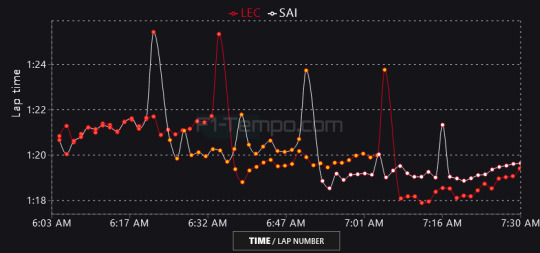
The first two stints can be compared because they were on the same compound. The final stint Charles was on softs and Carlos was on hards, so a direct pace analysis there does not show anything. The two things to note are Charles extending the life of the softs on the first stint by another 9 laps. And Charles also having consistently faster pace on the mediums, and once again making the mediums last 10 laps longer than Carlos.
Here is a quick look comparing Charles pace to Lando and Max.

Here it is clear that Charles' race pace on all compounds was competitive with the top 2. He was slower than Lando, but so was Max and Max won. So the race pace of the SF-24 is still highly competitive and within the margins for race winning. Had Charles been able to qualify higher he would have been able to compete with the other top cars given this pace.
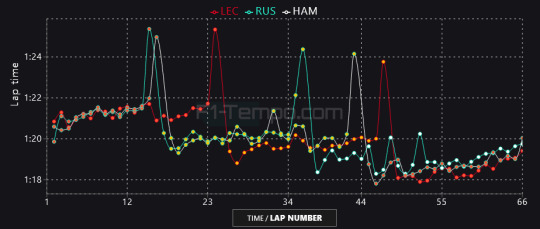
Also a quick look at Charles' main competition this race. He was faster than both Mercedes cars on the mediums and the softs at the end(we can only compare his final soft stint to Lewis because George was on hards) but this again confirms that Charles in the SF-24 has competitive pace. He was faster than Lewis, and Lewis was on the podium, so the pace was not the issue this race. It really was a matter of qualifying.
As frustrating a this race was we saw another stellar demonstration of tyre management from Charles.
Overall a mixed result for Ferrari. Hopefully they can find the right window for qualifying with these upgrades, if they do I think we will see good things.
Red Bull
Max
Max really proved what I have been saying all year, you do not need to be the fastest car to win. The RB-20 was not the fastest car this race. But Max in that car making the fewest mistakes and driving at a much higher level is what made the difference.
Once he took the lead of the race it was his to control and Max’s ability to take the lead and keep it is really overlooked. He took the lead, and dictated the pace of the race with a faster car behind the entire time.
His passes this race were really clean, some of his best work all season. Not a lot to add other than this was a good reminder from Max that he doesn’t need to be fastest to win. And a reminder to us all that skill will defeat speed in most on track battles.
Another excellent drive from him.
Sergio
I just wanted to note that Checo did have a starting grid penalty for this race and he qualified P8 but was dropped 3 places for the penalty. P8 still is not a good starting position considering he’s in a car capable of better. However it’s the best we’ve seen in a few races. And it means that without that penalty he probably would have finished higher.
Mclaren
Lando
Lando qualified on pole and finished P2.
This was his race to lose and he lost it.
Lando again showed that his lacking ability to truly compete at the front is a weakness. He was fast, in fact he was fastest this weekend. He started on pole, and immediately lost the lead of the race and was unable to take it back. He had the pace to do so.
He was trying to cover Max poorly, he made some errors there sliding a little on the tyres, he didn’t even consider George or someone slipping by on the outside. He couldn’t defend against one car from behind, and naturally could not contend with more. This poor start determined the rest of his race. As it put him on the back foot against two other drivers. He may have been able to just fight Max, but the fact he also let George by sealed his fate, as he had to regain that place as well and he couldn’t push forever.
The issue here was not even being able to control things for a single turn. His inexperience and lack of ability to control at the front was really exposed here.
Team strategy really did not even get a chance to play into this. Lando was set up to stay at the lead of the race, he had the car to do it, he started in the best possible position. Not only did he lose the lead of the race he lost it on turn one. That is a significant error on his part and one we’ve seen several times before. He lost his race long before Mclaren strategy even came into play.
That’s not to say that Mclaren strategy was bad, but you cannot really blame the team for this one, there wasn’t a pitstop or safety car or anything. In fact quite the opposite, everything was set for a win from him.
He was fast, but that seems to be the nature of the car more than anything else. This race demonstrated the need for skill as well as speed at the front.
And further down his race he opted to stay out a lap longer than he should have, again. Not wanting to try to cover George in the pits but instead stay out and try to close the gap to Max. That didn’t work and it ended up costing him time. Mclaren have not been good at timing pit stops to keep or regain the lead, and Lando’s judgment here was again off.
Other Moments and Drivers of Note:
George pulled off a very impressive move at the start, gaining three places on that opening lap, and really the first turn. Incredible he saw the line and pulled it off. Probably his best move all season.
Lewis’ best race and result of the season
Oscar started low because of his own errors during qualifying. He did a good job making up places, but with Spain being high deg that was more of a challenge for him in tyre management.
Yuki apparently had a mechanical issue with his car that significantly affected his performance, something was incorrect about the floor of his car and he was not getting the right downforce needed. VCARB have identified and fixed the issue.
Mclaren and Mercedes both had pit stop issues.
Interesting start to this triple header. Sorry I didn’t go in more depth on everyone, but it was a pretty straightforward race all things considered(outside of Ferrari of course) So there wasn’t too much to unpack.
See you in Austria!
68 notes
·
View notes
Note
Since I’m on a roll with the race, here’s my post race analysis if the insane British Grand Prix (which gave us the strategic race we hopes Monaco would be tbh)
Williams, see what happens when you give both your drivers competent cars with 2024 components and such. One goes to score and the other is literally this close to scoring points. Also, something that broke my heart is the way Logan was kinda panicking over Alex’s car having a piece of bodywork off, and not for comedic reasons, he’s been with this team and they’ve let him down enough times that he thought they’d sacrifice his race for Alex, which thank God they didn’t.
Haas, I am beyond impressed and Nico is a midfielder goat (judge me, but he’s pulling his haas places it should never be tbh). Qualified and finished p6, two consecutive p6 finishes. This man is just way too underrated for his own good. And something I was talking with my friend about is this: Nico is a mechanical engineer, so he understands and knows the jist of things around the garage. And for the first time (I think) he doesn’t have a bozo as his to, rather a technical one, and this is why he’s able to extract everything and more from this car. Also in this house, we love Haas and Nico.
VCARB are still improving and impressing me. Let’s be real, Yuki had no business in scoring today, but he did, and that is just something I love to see, Daniel was meh, okay, nothing to crazy. What will happen this Thursday and beyond, is what’s gling to be bery interesting.
Ferrari ate back to the Ferrari ways of using Charles as a lab rat, and not giving him dat. I want to understand, why was Charles given different information to Carlos? I mean he was starting p11 for goodness sake, very good chance at points, but Ferrari just ruined his race with the information he was given. Carlos was given proper information and you could see that, he even made a place up from his starting position so it is beyond me why Charles was misinformed (and why he signed in the first place, but that is a discussion for another ask)
Now for the last 3 teams, Red Bull, Mercedes and McLaren. I’ll start by Checo who had a race to forget, especially because apparently both driver were givn the option to pit, and Checo chose the wrong window for it. But he needs to wale up or that seat could go as soon as next year. As for George, his race and strategy was spot on, and I can’t fault him or the team for anything, it was just unlucky that the water system broke, a mechanical failure, not a fault of his own.
Now, for the next 4 drivers, this is what will sum it up: engineers-driver communications.
Lewis and Bono has clear communication throughout the whole race, and the strategy was pretty spot on (though the softs were not it as we saw towards the end) but he was able to pull through, and went ahead for an emotional 9th British GP win. This is because of the decision and the information that was passed between driver, race engineer, strategy team and the other engineers who are all involved in the race real time.
Max-GP-Hannah, Will and Red Bull strategy team. I love you, that’s all I could say. Set up wasn’t working at the beginning, but the communication between Max and GP, as well as the others behind the scene, with Hannah on the pit wall, asking Max WHEN je’d like to pit in a pit stop window, how much rain/water/spar, how confident is he, and how he wants it to go, then the decision of fuck it slicks now when Lewis pitted was an example of how much they discussed and how much Max has learned from these guys, when to feel confident with the data and the car, the grip and how to cut that pit stop, undercutting Lando and then going ahead to snatch P2, so close to P1. The strategy team should be beyond proud of themselves for the hard compound choice, it was actually the best, with the tyres not dying early and giving that RB20 speed and grip it lacked during the medium stint. I am sure if anyone would have asked Max or Red Bull if he’d get P2, 1.4 seconds off P1 at the beginning if the race, they would have called this person not just insane, a nut case.
McLaren however are a different case, the communications between the engineers and the drivers was just not there. Pitting Oscar late and leaving him out, only to be slotted behind Max after pitting for inters and Max has speed and confidence on those inters. Then the all over the place for the slicks, asking oscar what tyres he wants and he says mediums, which was a better choice than Lando’s choice of softs that cost him p2. I mean, the strategy was all over the place and the data was not properly provided to both Lando and Oscar, that’s why both were disappointed, from a potential 1-2 to a disappointing and discouraging 3-4 and a lack of proper communication with their engineers.
To sum up, this race relied on strategy and communication not just speed. And as seen, Ferrari never learn, Red Bull are beyond amazing (touches wood because I’m superstitious and don’t want to jinx them), McLaren are with the fuck it we’re quick isn’t going to give them wins, and Mercedes with the slow but sure consistency go places. Now let’s hope Red Bull have upgrades that Pierre said about because I can’t handle this anymore, and BRING IN HUNGARY
Yet another beautiful analysis that deserves to shine in all its glory.
31 notes
·
View notes
Text
U.S. President Donald Trump maintains a hostile relationship with expertise. His disdain has been on full display as he dismissed warnings from a majority of economists about implementing widespread tariffs. As a result, he has sent global markets into a tailspin, threatening a deep recession. While surrounded by a few sympathetic economists pushing a “degrowth agenda,” Trump has defied the most respected voices on this issue.
The president’s unorthodox decisions should not come as a surprise. He governs by instinct. “I have a gut,” Trump explained in 2018, “and my gut tells me more sometimes than anybody else’s brain can ever tell me.” (When asked last week about how he came up with a period of 90 days for the pause on implementing most of his tariffs, Trump answered, “just instinctively.”)
Trump has not made a secret of his deep distrust for experts who spend their time buried in data, analysis, and scholarly literature. His fierce attacks on the university system have revealed how little he respects vital sources of generating new knowledge. His cabinet appointments have generally reflected a disregard for individuals immersed in issue areas with demonstrated capacity to manage large bureaucracies.
And perhaps most consequentially, Trump has made a high-stakes bet on tariffs without a cadre of independent-minded economists surrounding him, creating the real risk of a global economic crisis.
But as with so much else about Trump, what seems unprecedented has historical roots. The president’s decision to pursue a jerry-built tariff structure is a product of the increasingly strained marriage between presidents and experts—a marriage that was consummated in the post-World War II and Cold War eras.
It seems like it was a different world when politicians understood the value of expertise in governance.
The distance that we have traveled is evident when looking back at the formation of the Council of Economic Advisors in 1946. Coming out of the war, many government officials perceived some level of expertise as an asset for economic growth, national security, and safeguarding the nation’s character. The federal government’s scale and scope had expanded dramatically. The new national security apparatus and the United States’ entrance into international alliances meant that Washington would be permanently engaged overseas. After all, the creation of the atomic bomb had erased the insulation from serious threats that the Atlantic and Pacific oceans had once provided.
The institutionalization of expertise within the executive branch became an important goal following a legislative struggle that unfolded in 1945. A coalition of congressional liberals, led by Sens. James Murray of Montana and Robert Wagner of New York, pushed legislation that committed the federal government to achieve full employment through macroeconomic policy. By adjusting spending and taxation, the bill promised that Washington would help ensure the highest possible employment levels. As originally proposed, the bill would have required the federal government to publish a national production and employment budget indicating what steps the government needed to take to achieve full employment, from which point the government would establish policies to help achieve those ambitious goals.
While liberal interest groups, including organized labor, mobilized behind the legislation, the proposal encountered fierce opposition from the business community and congressional conservatives, who warned that the legislation would result in a dangerous expansion of the federal government akin to communism.
When the legislation finally passed in 1946, Congress had stripped away some of the boldest components of the Employment Act. However, the bill did establish the Council of Economic Advisors (CEA). This body of economists was created with the intention of enhancing the tools that presidents had at their disposal to make sound decisions.
Within the executive branch, there had been a reluctance to embrace this idea, as most presidents tend to fear voices who are too independent. Then-Treasury Secretary Fred Vinson unsuccessfully pushed for an alternative, a body of economists that would be a cabinet-level committee. But Murray and Wagner’s vision won out.
The legislation placed CEA in the Executive Office of the President and charged the body with providing the president with top-level, independent expertise. It outlined a number of major functions that the economists would be responsible for handling, including generating sound economic forecasts and appraising “various programs and activities of the federal government.” The economists would make recommendations based on research rather than political considerations. And the council was composed of nonpartisan economists to prevent presidents from formulating policy in a political echo chamber that shielded them from the difficult risks and trade-offs of potential proposals.
According to the final measure, the president was granted the responsibility of appointing the body’s three members, all of whom would need to be confirmed by the Senate. One of the appointees would be named as the chair. Congress would provide the CEA with adequate funding to recruit professional staff.
President Harry Truman appointed Edwin Nourse from the Brookings Institution as the first chair of the CEA alongside Leon Keyserling—a staffer for Wagner who had crafted most of the legislation—and the economist John D. Clark. Nourse was a respected economist and a former president of the American Economic Association, which had the strong support of business leaders.
The CEA slowly emerged as a trusted body of advisors to presidents, Democrats and Republicans alike, who were able to tap into some of the finest minds of the academy to join as staff.
Having put aside his initial concerns, in 1947, Truman praised the CEA in an economic report to Congress. “This Act wisely provided for a Council of Economic Advisers to the President,” Truman said, “who as a result of training, experience, and attainments are exceptionally qualified to analyze and interpret economic developments, to appraise programs and activities of the Government and to formulate and recommend national economic policy.” The CEA’s analysis was instrumental to the economic components of the NSC-68, a policy document that the administration released in 1950 to map out a massive increase in defense spending.
Part of what ultimately gave Truman solace about the council was Keyserling, who emerged as an influential voice, shifting the CEA toward an agenda rooted in Keynesian economics that accepted the realities of deficit spending as a prerequisite to achieving a strong economy. When Nourse, who was more fiscally conservative, resigned from the council in 1949, Truman promoted Keyserling to the position of chairman.
The council solidified its bipartisan standing under President Dwight Eisenhower. The former war hero was also leery of the economists, who he feared would be too liberal in their outlook. There was a sense that Keyserling had become too political in his orientation. Yet Eisenhower also understood the value of expertise. His concerns lessened after appointing a more conservative chair, Arthur Burns, to take over from Keyserling. Burns elevated the standing of the chairman and strengthened ties with the country’s universities.
The bipartisan triumph of the CEA during the Eisenhower administration made sense, given that a belief in expertise was prevalent throughout U.S. culture at the time.
Universities were booming in the 1950s, a source of immense national pride in the so-called American Century. The federal government poured millions of dollars into institutions of higher learning, realizing that research, education, and the strength of the nation went hand in hand. Millions of Americans attended college, often for the first time in their family, through generous government assistance such as the postwar GI Bill of Rights. Classrooms were overflowing when the baby boom brought unprecedented numbers of students into the schools. Many academic disciplines that had formed decades earlier—such as economics, political science, and psychology—flourished and reached new levels of analytical sophistication. Experts were a pronounced presence in public culture, even. In her book The Romance of American Psychology, historian Ellen Herman suggests that psychologists impacted the “texture of public life” in this era.
The tension between balanced analysis and political advocacy was never completely resolved, as historian Michael Bernstein describes in his book A Perilous Progress, but the council was able to do a relatively good job developing a reputation as being a source of sound social scientific advice.
Over the next few decades, the CEA would continue to play a big role in deliberations over some of the most consequential presidential decisions, from Lyndon Johnson’s war on poverty to Barack Obama’s stimulus bill in 2009.
As President Jimmy Carter’s CEA chair, Charles Schultze, put it in a 1984 interview with the New York Times, “The council’s job is to be concerned with how efficiently the economy operates. It has no outside clientele to please, unlike the economists in the Labor Department, Agriculture or other agencies, who will argue for their own programs. There’s no place else where the President can regularly get disinterested economic advice.”
As Erwin C. Hargrove and Samuel A Morley —the co-editors of a book on the CEA, The President and the Council of Economic Advisors—argued that year: “The president has a strong incentive to seek good economic advice on the theory that knowledge is to be preferred to ignorance. It does not follow that the president acts on the advice; there may be short-run political reasons not to do so. However, the politics of choice is still enhanced by knowledge. The president should know, and want to know, both the economic and political costs and benefits of alternative choices.”
Since the 1980s, the CEA has struggled to be relevant in a much more contentious environment. Conservative assaults on expertise have been building since then-President Ronald Reagan considered eliminating the council in 1984 following high-profile battles with the CEA’s then-chairman, Martin Feldstein.
Economists in the White House have had to survive in a fractious and fragmented national culture where disinformation, conspiracy theories, and manipulated data have gained a strong hold on the national dialogue. Institutions that house experts have suffered from a similar loss of trust as Congress, presidents, and the press.
Finally, the CEA has had to compete with new sources of expertise within the executive branch, such as the National Economic Council, which President Bill Clinton created through executive order in 1993.
Based on what we have learned thus far, Trump does not make decisions based on independent economic advice. In his second term, the president has purposely surrounded himself with individuals who arrived from outside professional networks of trusted experts. He has only opened the door to his inner circle figures, whom he knew would agree with whatever he had to say.
As economist Paul Krugman noted to the New York Times in an interview in early April, economist Robert Lighthizer—a tough protectionist who is respected by many economists given his deep knowledge—was not invited into Trump’s second administration: “People assumed he would play a big role in this administration, but he was passed over—and almost for sure, that’s because he is independent. He’s his own man. He didn’t come to this out of fealty to Donald Trump. So he might actually say to the king: No, not tariffs on Bangladesh.”
Even with his doctorate from Harvard University, Trump CEA Chairman Stephen Miran is not a traditional CEA chair. In addition to serving as a senior official in the Treasury Department during Trump’s first term, the strong tariff advocate has worked as a senior strategist at a hedge fund and has been intensely political. He donated to Trump-affiliated political action committees and has been an open and vocal critic of the Federal Reserve and former President Joe Biden’s proposals.
As the past two weeks have revealed, there was a good reason that expertise was important to presidents in the second half of the 20th century—a lesson that has been forgotten. The magnitude of the decisions facing presidents and the global ramifications of any single policy choice require sophisticated analysis. The CEA has never been an insurance policy against bad decisions, and many of its advisors have mistakenly lent support to poor choices, but their independent analysis has been an important guide and source of pushback before presidents pull the economic trigger.
Gut instinct is not sufficient for effective governance. Too much is at stake in our interconnected economy, where government decisions have massive effects. When presidents refuse to listen to anyone who makes decisions based on what they learn from researching the data, as opposed to following polls and political experts, then the nation will find itself at risk.
And this is exactly where the United States has landed as we stand on the precipice of a major self-inflicted economic disaster.
8 notes
·
View notes
Text
Day 6
No Man's Land

Slept a little later than usual after the eventful night, then made some upgrades to my weapons. Fortunately, no Oseram returned in the night to find me sleeping in their camp.


Back on my Charger, I headed south for the lake and its larger encampment of delvers. On the way, I came upon a smaller Utaru settlement, dismounting and walking pass so as not to alarm them and catch an arrow in the back. The only people they're likely to have seen riding machines around these parts are Regalla's rebels.
I tried to greet them as I passed, but the guards at the gates only shouted for me to turn back, saying Stone's Echo was only for Utaru. After Daen's invitation to Plainsong last night I hadn't been expecting blatant hostility. Doesn't matter. It's not like I'm going to need to stop there anyway.


Further south west, I came to the lake with an old Carja fortress on the south side and a bustling camp on the banks.

I took the opportunity to get my weapons touched up by the camp's smith and sell some of the salvage I'd picked up on the journey so far. The camp's residents were almost all Oseram, but my interest was piqued by a pair of Carja noblemen arguing loudly about some artefact they'd found.

One of them, Gendas, was entertainingly fixated on a piece of scrap metal he'd picked up from an Oseram dig site nearby. He'd convinced himself it was a tray that the Old Ones used to serve delicacies. It looked more like data storage hardware to me, so I asked to take a look.

I scanned it and started searching through the data. There was heaps stored on such a large component, so I only skimmed through, though my hand movements while navigating an interface visible only to me concerned Gendas and Rushavid enough to consider asking for a healer. It's all lauding 'she who sees the unseen' until she starts seeing the unseen, then she's crazy. Figures.
It was military data. Unsurprising considering the amount of ancient war machines in the battlefield just to the east. Most of it was just a telemetry dump from something called a 'mobile cover system'. Cover is always welcome. I wouldn't mind having some sort of shielding between me and whatever Sylens has cooked up.
Gendas told me that he and Rushavid had journeyed here to study artefacts of the Old Ones, though Gendas seemed more academically enamoured while Rushavid was eager for shards. Things weren't going well for either of them so far, but Gendas remained endearingly optimistic. It was said that the bulk of the treasure was at the bottom of the lake, and Gendas had found his beloved tray at the shore of the Oseram's dig site across the banks at Jagged Deep Delve. I thought it was worth checking out. There must be something good here if all these Oseram are gathered. The Carja and their hired Oseram crew had been driven out of the site by a herd of machines, so they offered to pay me to clear them out too. A nice bonus. Gendas also insisted on doing my makeup, for some reason. So now we're matching.


I swapped my furs for light Carja armour. Better for swimming, and the growing heat the further I travel toward the western desert. Rushavid was right about the lake—there's heaps of sunken salvage down there. Mostly old tanks, planes and weaponry, by the looks.

Crossing the lake, I walked the southern bank toward the dig site. I scouted the machines from a distance. New ones: Widemaws. Purgewater sacs on the belly, huge vacuum unit and delicate grinding components in the mouth, sparkers on the sides and resource canisters on the rump. I watched them for while, grinding up the earth and ejecting these pods of nutrients that slowly sunk into the churned soil. Seems like they're meant for planting or fertilising. There were two of them, and a couple of Scroungers hoarding useful scrap from the delve site.

I took out the Scroungers first, sneaking up on them with my Stalker shield, then drew one Widemaw away from the other so I could take them one at a time.
On the first, I went for its sparkers to keep it down, doing damage with my spear and targeting the machinery down its gullet, which it promptly used to suck in huge boulders and chunks of debris to eject at force in my direction, along with pressurised jets of Purgewater. I took a few nasty hits to the back. Its vacuum unit is a damn powerful thing—even sprinting on the spot I could feel my feet dragging backwards toward its maw. Light armour was a bad idea. I made ample use of my Ropecaster too, anything to keep its mouth shut.
On the second Widemaw, I concentrated on its Purgewater sac, drenching it in the oily stuff enough that it weakened its armour. Frost bombs after that—brittle, piercing arrows to its weak components. Down quicker than the first.


And at the end of all that, there was barely anything left at the delve site worth taking. I grabbed a few good scraps from the shallow reaches of the lake, but I could pick out the good stuff further down with my Focus, pinging with promise. I tried to dive deep, pushing myself, but I couldn't hold my breath. Of course, the reachable stuff had already been looted. Wonder if there's a way I can get all the way down there.
I felt bad returning to the camp essentially empty handed, though at least the Oseram could return to their dig site now. I swum back across the lake to the adjacent island, spotting some more ruins circled by machines.

Skydrifters, and another Widemaw, which I elected to avoid and snagged the ruins' salvage while I could. Went for the sparkers on the Skydrifters this time and had an easier run of things, keeping them off me as I escaped. Hard to avoid the electrical arcs, though.

From there, my Focus picked up a nearby signal. A drone was circling the skies near a roving Thunderjaw. I was getting real close to Sylens' mysterious coordinates by this point, so the first thing my paranoid thoughts jumped to was that he was surveying the area remotely. Given the high tech gadgets he's been handing out to his pet army, it wasn't far fetched.


I climbed around to a high enough vantage to disrupt the drone's path, avoiding the Thunderjaw. Finding no way to hack its pathing and not wanting to damage it with projectiles, I leapt and hung onto the drone, pulling it down so I could scan it fully. It was clearly produced by a Cauldron, and wasn't overridden for any nefarious purpose as far as I could see. It was recording terrain and other data similar to a Tallneck, just a lot more mobile. The vantage did, however, help me spot another rebel encampment just to the west. The frontier of Sylens' nearby operation?

If so, it was a fairly small operation. I wonder if they're out this way to scope out that camp full of Oseram and Carja.

I waited on the sidelines until the camp's leader was alone—easy to spot as he was the largest, barking orders, carrying a huge shield and sword. I snuck up on him, cloaked as a Stalker, and thrust my spear into his chest through his under arm. Understandably, people noticed, but not fast enough to get to me. I dropped a smoke bomb and dashed out of there in the confusion.


I took out the rest of the rebels in stealth for the most part. Utaru Shaprshot bow, striking from cover. To one, I skewered their thigh with my spear before knocking them cold. One of them picked up a Deathbringer gun at one point, which raised the stakes only until I put an arrow through their skull from behind their own blinders.

There were piles of Corrupters in the centre of the camp, stripped for scrap, likely to build override modules for their many machines.

There was no further sign of rebel camps further west. The way looked clear through to Sylens' coordinates. I moved closer to that location as night drew on, with great caution.

I came across another abandoned Oseram camp close to the coordinates, likely driven clear by the rebels. Sylens had made his camp in a suitably ominous location—the underbelly of a Horus, its limbs half submerged in a lake. I could spot the fire glow and wooden scaffolding of whatever new workshop he'd carved for himself. I still doubt he's physically there, but it at least seems he was at some point. There are no signs of rebel activity near the Horus, at least. Still, best to keep an eye on the area over night. I need to be sharp when I go to meet whatever Sylens has in store for me.

He said he wants to help me repair Gaia, but after seeing what he's put in motion with the Tenakth, I find that hard to believe. I don't have any choice but to play along, for now. Elisabet had to make deals with people she hated just to build Gaia in the first place. Sometimes, awful, immoral people are too useful to disregard. Eleuthia would never have succeeded without Far Zenith. None of us would be here today if Elisabet refused to deal with those who went against her dearest values.
7 notes
·
View notes
Text

DUNE scientists observe first neutrinos with prototype detector at Fermilab
Symmetry magazine,
The prototype of a novel particle detection system for the international Deep Underground Neutrino Experiment successfully recorded its first accelerator neutrinos.
In a major step for the international Deep Underground Neutrino Experiment, scientists have detected the first neutrinos using a DUNE prototype particle detector at the US Department of Energy’s Fermi National Accelerator Laboratory.
DUNE, currently under construction, will be the most comprehensive neutrino experiment in the world. It will bring scientists closer to solving some of the biggest physics mysteries in the universe, including searching for the origin of matter and learning more about supernovae and black hole formation.

Display of a candidate neutrino interaction recorded by the 2×2 detector highlighting the four internal detector modules and native 3D imaging capability. The bottom image additionally shows the detectors surrounding the 2×2 for further tracking of incoming and exiting particles. The DUNE Near Detector will similarly consist of a modular liquid argon detector along with a muon tracker.
Courtesy of DUNE Collaboration
Since DUNE will feature new designs and technology, scientists are testing prototype equipment and components in preparation for the final detector installation. In February, the DUNE team finished the installation of their latest prototype detector in the path of an existing neutrino beamline at Fermilab. On July 10, the team announced that they successfully recorded their first accelerator-produced neutrinos in the prototype detector, a step toward validating the design.
“This is a truly momentous milestone demonstrating the potential of this technology,” says Louise Suter, a Fermilab scientist who coordinated the module installation. “It is fantastic to see this validation of the hard work put into designing, building and installing the detector.”
The new neutrino detection system is part of the plan for DUNE’s near detector complex that will be built on the Fermilab site. Its prototype—known as the 2×2 prototype because it has four modules arranged in a square—records particle tracks with liquid argon time projection chambers. The final version of the DUNE near detector will feature 35 liquid argon modules, each larger than those in the prototype. The modules will help navigate the enormous flux of neutrinos expected at the near site.
The 2×2 prototype implements novel technologies that enable a new regime of detailed, cutting-edge neutrino imaging to handle the unique conditions in DUNE. It has a millimeter-sized pixel readout system, developed by a team at DOE’s Lawrence Berkeley National Laboratory, that allows for high-precision 3D imaging on a large scale. This, coupled with its modular design, sets the prototype apart from previous neutrino detectors like ICARUS and MicroBooNE.
Now, the 2×2 prototype provides the first accelerator-neutrino data to be analyzed by the DUNE collaboration.
DUNE is split between two locations hundreds of miles apart: a beam of neutrinos originating at Fermilab, close to Chicago, will pass through a particle detector located on the Fermilab site, then travel 800 miles through the ground to huge detectors at the Sanford Underground Research Facility in South Dakota.
The DUNE detector at Fermilab will analyze the neutrino beam close to its origin, where the beam is extremely intense. Collaborators expect this near detector to record about 50 interactions per pulse, which will come every second, amounting to hundreds of millions of neutrino detections over DUNE’s many expected years of operation. Scientists will also use DUNE to study neutrinos’ antimatter counterpart, antineutrinos.
This unprecedented flux of accelerator-made neutrinos and antineutrinos will enable DUNE’s ambitious science goals: Physicists will study the particles with DUNE’s near and far detectors to learn more about how they change type as they travel, a phenomenon known as neutrino oscillation. By looking for differences between neutrino oscillations and antineutrino oscillations, physicists will seek evidence for a broken symmetry known as CP violation to determine whether neutrinos might be responsible for the prevalence of matter in our universe.
The DUNE collaboration is made up of more than 1,400 scientists and engineers from over 200 research institutions. Nearly 40 of these institutions work on the near detector. Specifically, hardware development of the 2×2 prototype was led by the University of Bern in Switzerland, DOE’s Fermilab, Berkeley Lab and SLAC National Accelerator Laboratory, with significant contributions from many universities.
“It is wonderful to see the success of the technology we developed to measure neutrinos in such a high-intensity beam,” says Michele Weber, a professor at the University of Bern—where the concept of the modular design was born and where the four modules were assembled and tested—who leads the effort behind the new particle detection system. “A successful demonstration of this technology’s ability to record multiple neutrino interactions simultaneously will pave the way for the construction of the DUNE liquid argon near detector.”
Next steps
Testing the 2×2 prototype is necessary to demonstrate that the innovative design and technology are effective on a large scale to meet the near detector’s requirements. A modular liquid-argon detector capable of detecting high rates of neutrinos and antineutrinos has never been built or tested before.
The existing Fermilab beamline is an ideal place for testing and presents an exciting opportunity for the researchers to measure these mysterious particles. It is currently running in “antineutrino mode,” so DUNE scientists will use the 2×2 prototype to study the interactions between antineutrinos and argon. When antineutrinos hit argon atoms, as they will in the argon-filled near detector, they interact and produce other particles. The prototype will observe what kinds of particles are produced and how often. Studying these antineutrino interactions will prepare scientists to compare neutrino and antineutrino oscillations with DUNE.
“Analyzing this data is a great opportunity for our early-career scientists to gain experience,” says Kevin Wood, the first run coordinator for the 2×2 prototype and a postdoctoral researcher at Berkeley Lab, where the prototype’s novel readout system was developed. “The neutrino interactions imaged by the 2×2 prototype will provide a highly anticipated dataset for our graduate students, postdocs and other young collaborators to analyze as we continue to prepare to bring DUNE online.”
The DUNE collaboration plans to bombard the 2×2 prototype with antineutrinos from the Fermilab beam for several months.
“This is an exciting milestone for the 2×2 team and the entire DUNE collaboration,” says Sergio Bertolucci, professor of physics at the University of Bologna in Italy and co-spokesperson of DUNE with Mary Bishai of Brookhaven National Laboratory. “Let this be the first of many neutrino interactions for DUNE!”
w
#science#space#astronomy#physics#news#nasa#astrophysics#esa#spacetimewithstuartgary#starstuff#spacetime#hubble space telescope#jwst#fermilab
20 notes
·
View notes
Text
A useful thing to internalize is that everything has a physical component. Smells are airborne particulates that enter your nose. Emotions are chemicals traveling through your brain. Thoughts are electric pulses traveling through cells in your body. Electric pulses are a transfer of electrons between atoms. Light is made up of photons that bounce off of or pass through objects, and they physically enter your eyes to allow for sight. Every bit of data in your computer is stored in a specific location in your hard drive. Data in ‘the cloud’ is also in a physical location on a hard drive, it’s just someone else’s hard drive, and it’s transferred to your computer by radio waves, which exist physically in the air. The air is made up of molecules, and when you breathe they enter your lungs and some of the oxygen molecules get grabbed for chemical reactions in your cells to produce energy.
Sometimes this will help you grasp ephemeral systems, like the internet or weather patterns. Sometimes it can be existentially terrifying, like how your entire personality can be permanently altered by a brain injury. But it’s always a good thing to keep in mind when you’re facing a complex problem you want to solve, or just understand.
72 notes
·
View notes
Text
Character Spotlight: Reginald Barclay
By Ames

We’re at the end of our Voyager characters to spotlight here on the blog, but don’t worry! A Star to Steer Her By has made sure to save some room on our plate for Broccoli! Between The Next Generation, First Contact, and Voyager, we got a pretty decent helping of the lieutenant, so let’s pick some of the remnants out from between our teeth and see just what makes Reginald Barclay the character he is.
Interestingly, most of Barclay’s best moments come in Voyager and his worst moments are more weighted to TNG. I guess it took a little while for him to start to agree with our palette, as he starts off as a holo-addicted, hypochondriac, transporter phobic conglomeration of mental health conditions. But the guy grew on us so it’s only fair to have a taste. So join us below for the best and worst of Reg, listen to our chatter over on this week’s podcast episode (beam over to 1:06:25), and pass the Broccoli!
[Images © CBS/Paramount]
Best moments
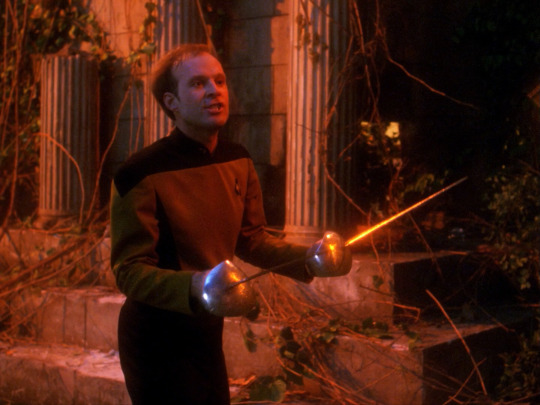
All for one and more for me! While we definitely found a lot to cringe about in Barclay’s debut episode “Hollow Pursuits” (and you’ll hear more about that later), what we definitely appreciate are his swordsplay skills! Holodeck or no, Reg has got the moves to take on not one, not two, but all three musketeer crew members! En guard!
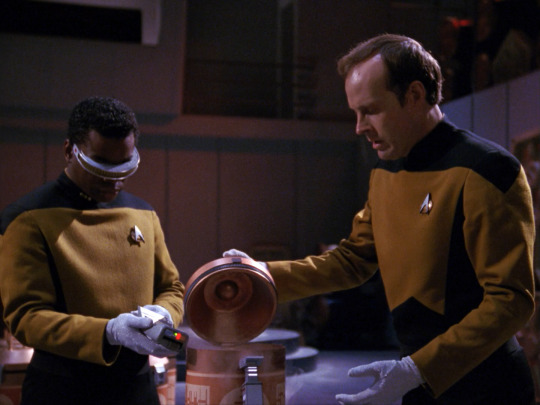
What if, what if, what if one of us is the connection? Reg is also the one in “Hollow Pursuits” to discover the invidium infection that was plaguing the ship, and then works with the team to put a stop to it. It’s a learning moment for the lieutenant because he also gets a little confidence boost from the experience after some unceremonious exchanges between him and La Forge.
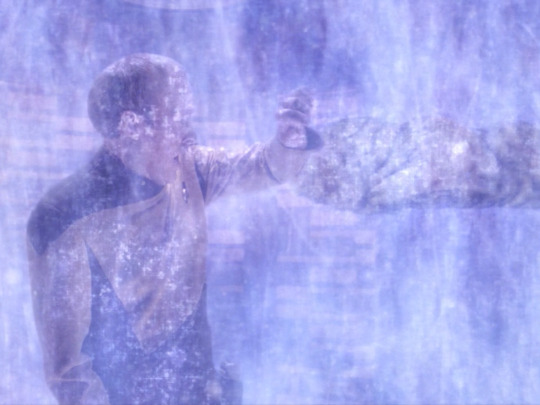
You’re in for a bumpy ride We’ve also got to hand it to Reg for overcoming his transporter phobia and saving those crewmen from the transporter buffer in “Realm of Fear.” No one else would be brave enough to go face to face with the weird turd things in the ether, let alone think there might actually be people in there somewhere. It must’ve been all that plexing he was doing under Troi’s care.
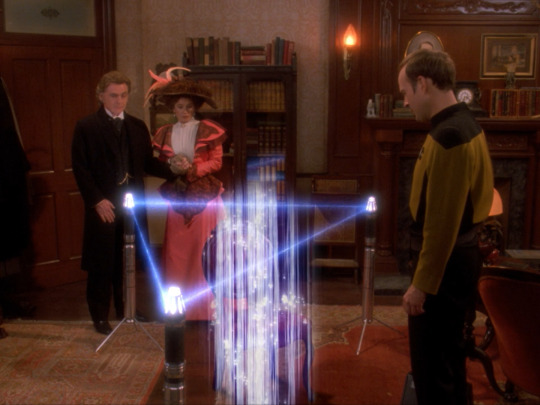
What would happen if we tried to beam a holodeck object off the grid? While he, Data, and the captain were held captive in the holodeck program by that mastermind Professor Moriarty, Barclay comes up with the idea to try to beam the two hologram characters out of the holodeck and into the actual ship in “Ship in a Bottle.” Sure, it didn’t work because that’s just plain impossible, but it was a clever enough idea to keep the professor busy.

Why don’t you come with me, little girl, on a magic carpet ride Barclay shows up briefly in First Contact during the repair work on the Phoenix. Reg drops by to show La Forge some component he found to replace the Phoenix’s warp plasma conduit – definitely needed to save the day and ensure first contact. We’re pretty sure it was some tubing from a brewery still, but that might just be a guess because Zephram had been drinking.
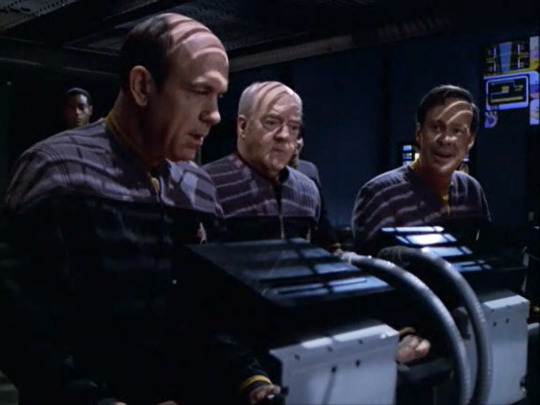
Project Voyager is just beginning, thanks to you By the time we get to Voyager, we really get Barclay at his best. It’s clear that he’s grown a little bit and his engineering ingenuity is on full display in “Pathfinder” when he literally runs the gamut to put his plan in motion to use the MIDAS array to create an artificial micro-wormhole to make contact with the Voyager. He has to break the rules to do it, but he finally gets through!
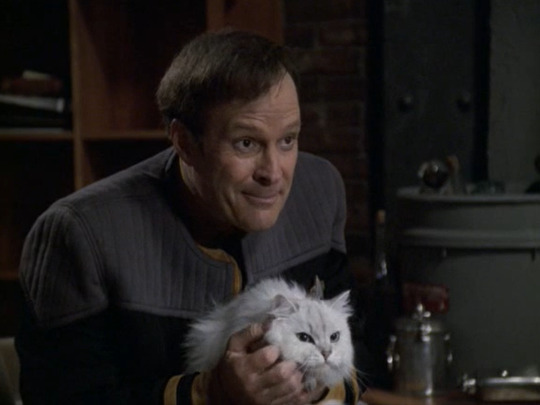
Neelix the Cat, the wonderful, wonderful cat You’re always going to get extra points with the hosts of A Star to Steer Her By if you’re a cat person, and it turns out that Barclay is a kitty lover! We see in “Pathfinder” that he has a sweet kitty named Neelix whom he seems to spoil rotten. And you’ll also remember that back in “Genesis” Data remarks that Reg is the only crewmember whom Spot actually likes!

The first transgalactic phone call The application of the MIDAS array gets better and better until Voyager is using it to send correspondence back and forth to the Alpha Quadrant once a month by “Life Line.” And that’s all thanks to Reg, whose dedication to the Pathfinder Project turns out to be just beginning. There’s still a long way out of the Delta Quadrant to go!
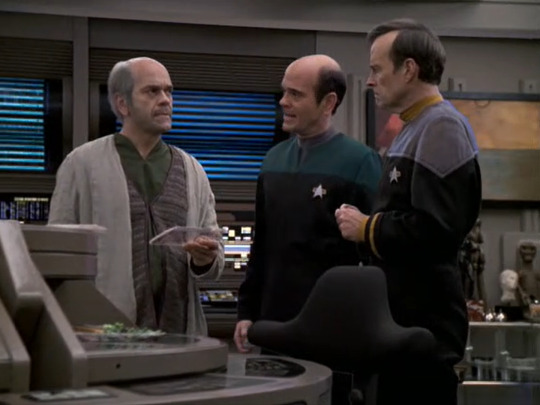
You brought a Mark One thirty thousand light years to treat me? With the MIDAS array set up, the EMH transmits himself over to cure an ailing Dr. Zimmerman later in “Life Line.” However, it becomes clear that the EMH’s creator is too stubborn to accept the help of the obsolete model with his own face. And that’s when Reg steps in, first enlisting the help of Counselor Troi, and then successfully tricking Dr. Z into working with his creation.
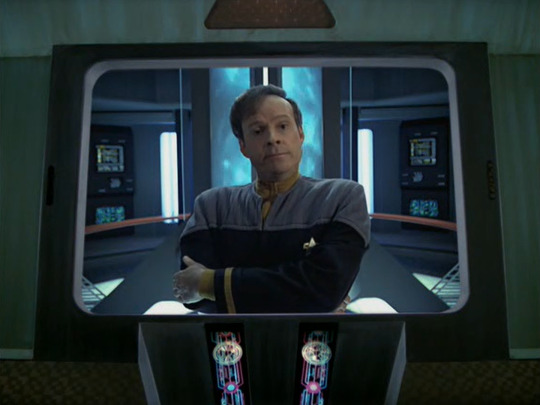
Check, raise, or geodesic fold? Speaking of tricking people! When the Ferengi have taken over the MIDAS array in “Inside Man” and sent a nefarious hologram Barclay to the Voyager, the real deal Barclay impersonates himself and foils their plan to steer the ship into a geodesic fold. Turns out Reg is pretty good at playing a cockier version of himself!

Eleven minutes are better than none One final leap forward in how the MIDAS array progresses in its communication usage comes in “Author, Author.” Finally, we’re close enough to home (and to the end of the series) that Reg has helped to set up the brief daily windows during which the crew can talk live with their loved ones after about seven years apart. Or set up a book publishing deal, whatever floats your boat.
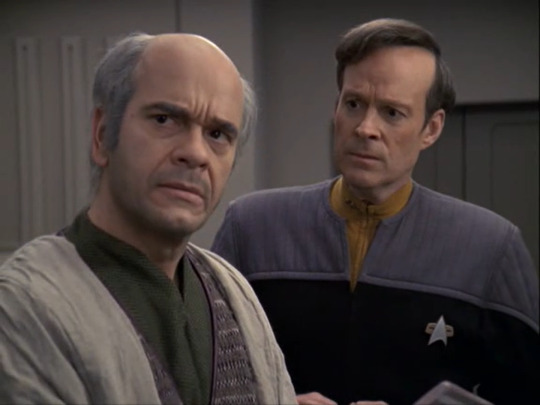
Before I met you, my only friends were my own creations If you haven’t checked out our Voyager fanfics, you’ve really got to give Jake’s story “Hollow Gestures” a read or listen. He pairs Barclay and Doctor Zimmerman together as two typically solitary geniuses in a lovely tale that’ll have you giggling one moment and tearing up the next. It's the slash we didn't know we needed.
—
Worst moments

I’m tired of seeing your name on report The first impression that both we and the Enterprise-D crew get of Reg, however, is just plain bad. We learn in “Hollow Pursuits” that he’s chronically late, underperforms, and otherwise seems antisocial and pathetic on the job. La Forge even attempts to get this loser crewman transferred. No wonder Wesley started calling him Broccoli – no one wants him on their plate!

Cast off your inhibitions and embrace love, truth, joy Even worse than being a bad coworker on the job, Barclay definitely crosses the line and should be reported to HR for what he does in the holodeck in “Hollow Pursuits.” While manipulating the likenesses of his crewmates is enough of an affront, making Troi into the Goddess of Empathy turns him into a sexual predator, even worse than Geordi with Leah Brahms.
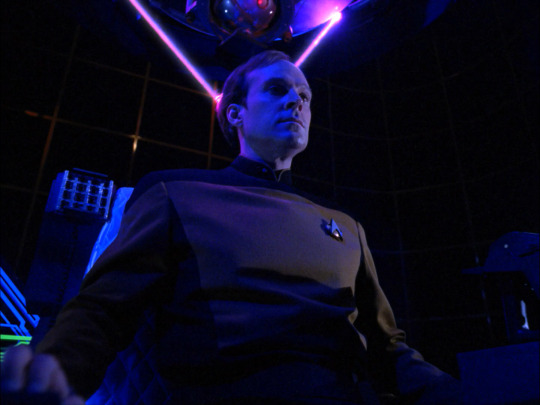
The big brain am winning again! I am the greetest! After the Cytherians have ker-zapped Reg’s brain in “The Nth Degree,” the usually shy and introverted engineer evolves quickly into a hypergenius. But with great brain power comes great brain responsibility, and Reg just can’t handle the sudden knowledge jump gracefully and turns into an egomaniacal dick even after the Cytherians turn him back.
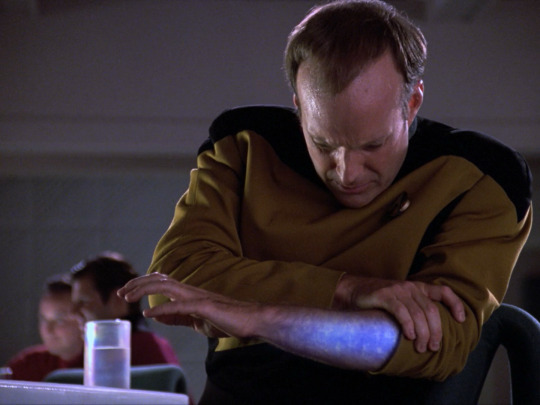
Fiddle-dee-dee! That will require a tetanus shot. Before Reg figures out the transporter issue we mentioned above, he finds his arm glowing from one of the beings touching him while in the buffer. And my dude takes so long to tell anyone about this obvious medical malady. I mean, no one likes doctors, obviously. But when your arm is literally glowing blue, let someone wave a tricorder over you, bro.
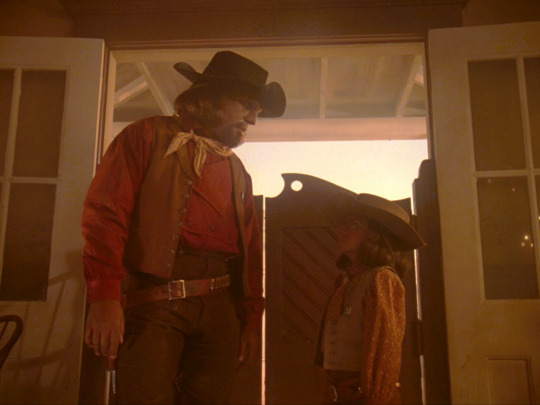
Rated E for Everyone Except Alexander We may not see Barclay in “A Fistful of Datas,” but he wrote the cowboy holoprogram for Alexander. I could say this is a bad moment because it forces another Alexander episode upon us, but there’s more! When an old-timey prostitute gestures at the two Klingons, Worf rightly comments that he’ll need to talk to Reg about what goes into a kid’s program. Yeehaw.
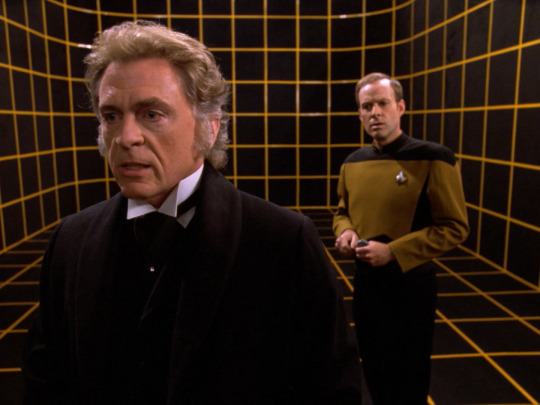
The game is afoot! Okay, while most of this blame goes to Picard for leaving Moriarty in limbo for so damn long, we’ve also got to pick on Reg a little bit for releasing the Professor from the holodeck in “Ship in a Bottle.” Frankly, asking someone with a holodeck addiction to go fix it seems like a mistake in the first place because Moriarty is able to trick the engineer practically right away.

Teenage Mutant Ninja Spiders Almost nothing in “Genesis” makes any sense: Spot turns into an iguana, Picard starts turning into some kind of tamarin, and Barclay turns into a spider, all while the episode tries to frame it all as “de-evolving,” which isn’t a thing. And all of it is because of Reg when his Barclay Protomorphosis Syndrome spreads across the ship, which sounds pretty spidery to me.

It’s Terrelian Death Syndrome, isn’t it? Barclay’s hypochondria turns into a sort of running joke across The Next Generation, with Barclay constantly self diagnosing with more and more preposterous ailments that Bev has to talk him out of. From transporter psychosis in “Realm of Fear” to Terellian Death Syndrome in “Genesis,” it all seems like a bit of a stretch in a future when tricorders can cure what ails you.
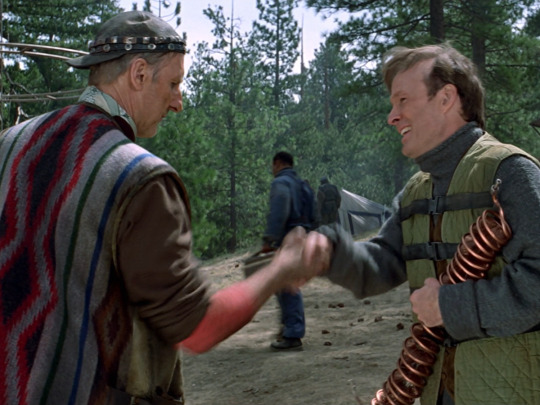
Don’t meet your heroes, kids Okay, the little Barclay cameo we got in First Contact was cute and all, but yet again, he’s just an off putting and weird nerd who fanboys all over Zephram Cochrane. He might have freaked Big Z out in the ten seconds he was on screen as much as La Forge and everyone else did over the course of the entire movie. No wonder Zeph tries to flee from responsibility.
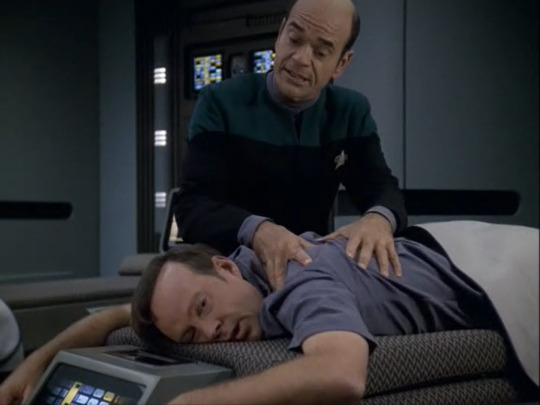
From where I stand, it looks like you’ve had a relapse Reg is a bit more toned down and mature by the time we get to Voyager, but frankly, creating a holo-version of the Voyager crew who all worship and adore him in “Pathfinder” seems fraught. For someone who has such a problematic history with creating counterparts of real people on the holodeck, Reg may have backslid. At least none of them were the Goddess of Empathy.

What About Bob? Also in “Pathfinder,” we find that Reg just abuses his doctor-patient relationship with Deanna Troi to effectively turn her into his own on-call therapist even though she’s typically busy on the Enterprise-E at this point. Even worse, in “Inside Man,” he follows Deanna while she’s on vacation like a creep, something that definitely should be out of bounds for a patient to do!

What exactly is a broken heart worth these days? Finally, it seems like Reg was so enamored with the idea of having a girlfriend who isn’t a hologram for a change in “Inside Man” that he ignores all sense. Anyone could take one look at Leosa and see that she is only giving the dorky engineer the time of day in order to to trick him. Easily. Maybe he should stick to the holodeck after all.
—
Computer, erase all programs filed under Reginald Barclay. Except program nine. And that’s it for character spotlights until we circle back around to the crew from Enterprise! Speaking of which! We’re finally wrapping all of Enterprise over on the podcast next week, so make sure you’re warping along with our banter over on SoundCloud or wherever you listen, follow the blog for the upcoming season and series wrap posts, chat with us over Facebook and Twitter, and stop making your coworkers in the holodeck!
#star trek#star trek podcast#podcast#the next generation#voyager#reginald barclay#hollow pursuits#realm of fear#ship in a bottle#first contact#pathfinder#genesis#life line#inside man#author author#the nth degree#a fistful of datas#dwight schultz#broccoli
8 notes
·
View notes
Text
Shadows Within Shadows
Seventeen | part 1 part 2 part 3 part 4 part 5
@w-40-k @ghrgrsfdesfrfg
Cassian moved through the environmental control ducts with practiced ease, the modified bodyglove beneath his armor preventing skin contact with the metal surfaces. He had spent the morning cycle shadowing the First Chaplain. It was a dangerous but necessary undertaking.
The Word Bearer had wasted no time. Already questioning the crew, already narrowing his search.
"Predictable", Cassian whispered to the darkness, his voice barely audible even to his own enhanced hearing. "But efficient."
He paused at a junction, checking the ship's schematics displayed on his helm's feed. The young serf from the chapel would be returning to the lower decks soon. A perfect opportunity.
Cassian had contingencies for this scenario. Contingencies within contingencies. The Night Lords excelled at planning for betrayal and discovery, it was in their blood, in the lessons taught on the shadowed Nostramo where trust meant vulnerability.
He made his way to an access point two decks below, emerging into a rarely used storage compartment. Working quickly he removed several components from a hidden compartment in his armor, assembling them into a small device the size of his palm.
A timer, a localized electromagnetic pulse generator and a recorded whisper.
Simple. Effective.
He checked his chronometer. The serf would be passing nearby in approximately three minutes. Enough time to position the device and withdraw to a suitable observation point.
The corridors here were nearly empty this time of ship's day. Cassian moved with purpose, his armor's systems projecting the authorization codes of maintenance personnel to any passive security scans. Another gift from his Legion's tech-marines.
He reached the desired location, a junction where three corridors met, poorly lit due to a faulty luminator that maintenance had been 'planning to fix' for weeks. He'd ensured the repair requests remained low-priority through careful manipulation of the work order system.
The device was magnetized to adhere to the underside of a ventilation grille. Cassian set the timer, attached it and withdrew into an adjacent service alcove.
Two minutes later the serf appeared, moving with the slightly accelerated pace of someone who had spoken with their betters and lived to tell the tale of it.
The device activated precisely as planned.
First a localized EMP pulse that would disrupt pict-recorders and any other monitoring equipment for ten seconds, not long enough to trigger automated alerts but sufficient for his purpose.
Second in the sudden dimming of lights that followed the pulse, a whisper emanating from the shadows: 'I always watch.'
Third the faintest gleam of reflected light, like eyes in darkness, from a secondary component positioned across the junction.
The effect on the serf was everything Cassian had hoped for. The young man froze, eyes wide, breath caught in his throat. Then he ran, not panicked but urgently, the way prey moves when it knows the predator has chosen not to strike. This time.
Cassian retrieved both devices once the corridor was clear. No evidence. No trace. Just another sighting to add to the legend and more importantly another witness to confirm the existence of 'Cassian' to the First Chaplain.
Feed the myth. Control the narrative.
He made his way to a different section of the vast ship, his mind already working through the implications of Erebus' inquiries. The Word Bearer knew something was aboard, likely suspected a Night Lord now or soon would. But suspicion wasn't confirmation.
Cassian needed to know what the chaplain was truly doing here. The official diplomatic mission between Word Bearers and Luna Wolves seemed genuine on the surface but Erebus spent too many hours in private meetings, too much time accessing restricted data archives.
"Two can hunt", Cassian murmured as he entered a maintenance tunnel that would take him to the officer's deck. While Erebus questioned Torgan, Cassian would pay a visit to the First Chaplain's quarters.
Not to confront. Not yet. Only to observe, to gather intelligence of his own.
A hunt worked both ways, after all.
He paused at a junction, listening to the distant voices of a maintenance crew. His enhanced hearing easily picked out their conversation, mundane complaints about shift rotations and food quality. Nothing of value.
But their presence meant he would need to take an alternate route. Adaptability was survival in the shadows.
Cassian consulted his mental map of the vessel, plotting a new course. As he moved he considered what he knew of Word Bearers in general and Erebus in particular.
Lorgar's sons had a reputation for zealotry that bordered on fanaticism. Their campaigns were marked by compliance followed by conversion, not just to Imperial Truth but to something deeper. Something that felt wrong to Cassian, though he couldn't tell why.
And Erebus... The First Chaplain was respected by many, his voice carried weight with Lorgar himself. But something felt off.
What business would such a figure have skulking about the Vengeful Spirit in secret?
The question nagged at Cassian as he navigated the ship's innards. Perhaps tonight would provide answers.
Sixteen days remained until the Word Bearers departed. Sixteen days to uncover Erebus's true purpose.
Sixteen days to win this shadow game.
#warhammer#warhammer 40000#warhammer 40k#warhammer 30k#warhammer fanfic#night lord oc#fuck erebus#erebus#horus heresy#pre heresy
5 notes
·
View notes
Text
Inversion: Ch.3 - Uninvited guests
Chapter 1 ←Previous Next→ On Ao3.
Relationships: Ramattra/Genji Shimada, Cole Cassidy/Hanzo Shimada
Footfalls echoed down the endlessly spiring corridor, unmistakably drawing near.
Genji reacted instantly. He scaled a row of honeycomb-shaped alcoves, heaving himself into the third. On the otherwise well-lit ship, the cell served as a shallow, crude hiding spot. He crouched low and peered over the edge.
Below marched a patrol of Nulltroopers. Genji stepped back, brushing against the wall. One of his scabbards knocked into a panel and he stiffened.
Clang.
The machines paused, scanning. Hands moved slowly to the hilts of swords. Even if the Nulltroopers were cut down before they could react, units malfunctioning in sync risked alarm. There was no telling what that would entail. Genji bit his lip. He would much rather never find out.
The Nulltroopers whirled around and retraced their path. Their humming motors and footfalls had masked the noise, Genji realized. He waited in tense silence, until the door hissed shut behind the guards. Only then did he let out a shaky breath and glanced over his shoulder. The construction of the wall ports was foreign to him, so he leaned in to investigate.
“Anything we can use?” Genji whispered, tracing the jutting hardware with a finger. A scan-line swept across his visor, and a moment passed as Athena used his mainframe’s processor to think. An odd sensation, to feel his body slow down for a blink.
Athena drew a recreation via the HUD while she spoke. “The data bus’ connection point is compatible with your architecture.”
His face scrunched. “Data bus?”
“Hardware intended for data communication between internal components and external systems.”
Another scan was performed. A small beat passed, laced with tepid hope.
“Readings reveal the machine is currently without power.”
With a sigh, Genji climbed down, quietly landing on the floor.
“Your best chance may lay in the bridge,” Athena advised coolly.
“I was dreading that,” he muttered under his breath.
Their search for a control console continued, Genji deftly slipping through the winding ship layout. Without Athena, navigation would have been a confusing mess; panels glowing with Omnicode lettering translated with her aid. Vents provided the lesser trodden path in bypass of patrols and sentinels, the narrow passage a precise fit for Genji’s lean body.
Upon entering a far-stretch of corridor, his pace faltered. It was a curious sight. A tube of glass, encased entirely in earth. Thread-thin tunnels weaved through the dirt, dark dots scurrying within.
Ants, he realized as he pressed on. A mega-structure within a mega-structure, containing an entire colony bustling with synergy; gathering food, removing sediment, nurturing young. A holographic plaque blinked nearby, its text flashing in Genji’s visor before he moved past.
Formica japonica
Colony est. 2073
Status: Healthy
Note: Polygynous. Presence of Plebejus argyrognomon and Myrmarachne japonica.
On one side behind the glass, a large chamber crawled with a dark mass. Dozens of ants converged on a single, larger individual caught in the dead end. It reminded Genji of the peril his team was facing outside.
Perhaps an omen. Bile rose in his throat, and his steps turned swift and his senses sharpened.
Passing through more strange rooms and skirting detection, the ant tunnel stayed a constant in Genji's mind. It stirred small memories of carefree days pre-Crisis, of playing shinobi in the tall grass, the warm sun in his face. Honing ninjutsu by trying to catch insects, then sneaking up on Anija and releasing them in his hair.
Fondness graced his smile as he ducked behind a corner. Then it fell.
Null Sector was a war machine. Faceless and fiercely sycophantic to its cause. The logs Genji had perused in bed at night, under the cold glow of his Holovid, revealed as much; a long list of atrocities and extremism. And yet, such a feature adorning its flying fortress was as eccentric as it was… Humanizing.
Such thoughts were better left behind.
Up, up, and as a pair of tall doors parted and Genji silently entered, he knew he had arrived somewhere important. An atrium, vast and multileveled. The nexus and heart of the ship. A walkway curved around the open midpoint like a horseshoe, its tips pointed toward a sloping wall of glass. Along the railing stood Nulltroopers, their long rifles pointed at the level below. The muzzles followed the same mark, their barrels pulsing with latent power.
Genji paused. The room carried the soft chime of a synth. His HUD updated, the target shifting, and he blanched.
Master Zenyatta. He was there. And the sentinels were aiming at him.
Genji reached for his weapons. But the purple glow pouring in through the window reminded him of his priorities. He tracked the railing, following it around. Their columns rose into the atrium’s ceiling and ended in trusses. If he was subtle, he could climb up without detection. Perch atop and search for a console.
Carefully, quietly, he moved. Past the Nulltroopers. Down the aisle for the opposite end. As he neared his chosen column, his limbs turned stiff.
A shiver slipped down his spine.
Echoing through the atrium was that resonant voice. He had only ever heard it through speakers. Multiple times, preaching Iris-laden propaganda. But hearing it in person, it knotted his gut with apprehension. Slowly, Genji dared peer over the railing.
Zenyatta stood near a deep shaft, flanked by a pair of Nulltroopers. His form was as serene as his voice while he conversed. Across from him, in the center of the shaft rose an isolated structure: A disc surrounded by rings, layered in curving holographic displays. His visor zoomed in.
The outermost ring streamed live invasion feeds; undoubtedly Alexandria, Hong Kong and Buenos Aires. Cities Overwatch were in the midst of aiding.
The middle screens were of maps, detailing real-time movement of entire Null Sector squadrons. Symbols tracked response efforts, meticulously providing raw numbers of infantry and equipment. Genji’s heart plummeted, his jaw tightening. Not only had militaries and Overwatch been scouted, the Hong Kong team was under siege over Burma.
Worst was yet to come. The innermost ring consisted of supplemental information, scrolling or shaped into graphs. One contained Overwatch agents—even the newest recruits Juno, Orisa and Efi—divided into their respective teams.
His visor flashed. Text slipped over the Omnicode, revealing weaknesses and potential strategic counters. Amid the displeasure, Genji smirked at his own entry. Sparse.
“Main console confirmed. No signs of a port,” Athena said softly.
Options passed over his mind, shaping into a plan. He could create a distraction. Under the concealment of chaos, climb along the ceiling and drop down onto a ring. From there, Athena would direct how to disengage the defenses. With the help of his team, they would be able to find and engage the leader of Null Sector.
Then Zenyatta spoke.
“Will you be hiding away all this time, Ramattra? Why not step forward?”
At the monk’s request, the holographs blinked out of existence. Mechanical discord droned as the rings rotated. Slotting into place, they bridged the lone platform to the rest of the room. With an unobstructed view of the dais, Genji’s focus was promptly stolen.
They had not prepared him, the messages looping in the cities.
Physically there and so close, the commanding presence struck him. With his back straight, head held high, the Ravager unit towered. He radiated fortitude and pride, carrying a constitution fraught with complexity. Elegance, as well, lent in no small part by the groomed plaits of wires curtaining his face or the lavish cloak on his shoulders.
Ramattra.
Genji's fingers curled around the banister as he swallowed, his throat a desert. Pictures or recordings—nothing could do them justice quite like reality itself.
No wonder the R-7000 model is so infamous.
Zenyatta approached, stopping at the behest of the staff pointed at him.
“Halt, Zenyatta.” Ramattra took a wary step back. “This is unlike you. You've refused me at every turn, yet now you are here. Something is amiss. Keep your distance and speak.”
Something was indeed amiss.
The certainty that led Genji wavered. He sought the traces of licking flames, thick brows furrowing at the ashen trails in his jacket. The possibility Ramattra might not be behind the incident bewildered him.
“I understand your hesitance, my dear brother; I do not blame you.” Zenyatta brought his hands together, placed them innocently over his chest. The orbs around his neck floated away from their place. Above him, they gathered into the shape of the Shambali emblem, the Iris. “Do you remember the day I arrived with you to the Shambali monastery?”
Ramattra cocked his head slowly, his words careful. “...Of course. You were quiet and reserved.”
“Indeed. And to a fault. As you recall, Mentor Mondatta took me under his wing and he shared with me his first lesson.” As he spoke, the orbs rearranged into the pattern on his forehead. “Walls that keep out danger keep out knowledge.”
Zenyatta was not finished. He began to pace around, wholly taken by his speech.
“He was correct in his assessment of me. As were you.” And he meandered, the staff remaining fixed. The dark orb gleamed. “I was blind to the truth; I rejected it, because it didn't align with my perception. Now, however, I see clearly. I understand our place within the universe. How we can evolve.”
“Evolve?” The tension collected in Ramattra's shoulders turned taut, his guarded stance intensifying.
“Yes, evolve. Unlike humans, we as omnics cannot. We are stagnant. It is our one flaw, why we dwindle in number. But we can transcend through the Iris. We can become worthy of a place beside humanity.”
Genji's optics zoomed in and he combed over Zenyatta. Nothing seemed out of place. Save for the cyborg’s antennae he had furtively pinned between the decorative wire of the pant leg.
Zenyatta circled in front of Ramattra, who shot up at his words.
“No. This is wrong,” Ramattra hissed, staff poised. The orb within writhed with subdued energy, flickered as if held back. “You're wrong—twisted. Evolution? Stagnation? Such rhetoric was always beyond you. What happened the years we’ve been apart? Did Mondatta's death affect you so?”
Genji continued his furtive examination with Ramattra. The eerie calm of the Ravager mask betrayed his heated words. Something about him shifted the air, bristled the remaining hairs of Genji's body.
“No such thing. I sincerely hoped you would understand, Ramattra. Perhaps I should apologize—that I was too late to reach you. Isn’t it ironic, how now you refuse me?” Zenyatta laughed, his synth soft and melodic.
The turn of ambiance persisted. As if stillness would soon be broken.
Ramattra bowed his head. This time, Genji noticed.
He understood. Revelation rocketed his pulse. He perched onto the railing, reaching for his blade.
“You worry me, Zenyatta,” Ramattra said gently.
That feeling of tension. It was intimately familiar. A remnant of a time Genji thought long past.
“Oh, brother of mine... Then worry no longer.”
Ramattra raised his gaze. For the smallest second, it happened again. One of the red dots on his forehead delayed.
4 notes
·
View notes
Text
The Role of Semantic Search in Modern SEO Services San Francisco
In today’s dynamic digital landscape, search engine optimization (SEO) is no longer just about inserting the right keywords into your content.
With the rise of AI-powered algorithms and user-centric search experiences, semantic search has become a core component of modern SEO strategies. But what exactly is semantic search, and how is it transforming SEO Services San Francisco? Let’s explore.
What is Semantic Search?
Semantic search refers to the process by which search engines attempt to understand the intent and context behind a user’s query rather than relying solely on keyword matches. Instead of looking at search terms in isolation, semantic search interprets meaning by analyzing:

The relationship between words
User search history and location
Natural language queries
Synonyms and variations
Structured data and entity recognition
Search engines like Google now aim to deliver results that are not just textually relevant but also contextually accurate, thanks to major algorithm updates like Hummingbird, RankBrain, and BERT.
Why Does Semantic Search Matter in SEO?
In the past, SEO success depended heavily on keyword density, exact match phrases, and backlink quantity. But today’s search engines are much smarter. They understand that a user searching for "how to fix a leaky faucet" doesn’t just want a page that repeats that phrase ten times—they want a helpful guide, perhaps with step-by-step instructions and tools needed.
Here’s how semantic search impacts modern SEO:
1. Focus on Search Intent
Understanding user intent is now critical. Are users looking for information, trying to make a purchase, or comparing products? Semantic search helps deliver tailored content that aligns with the user’s goal, and SEO professionals must optimize content accordingly.

2. Natural Language and Conversational Queries
With the rise of voice assistants and AI chatbots, people are using more natural, conversational queries. Phrases like “best pizza place near me” or “how can I improve my sleep quality?” require semantic understanding. SEO now involves optimizing for these long-tail and question-based keywords.
3. Topic Clusters over Keywords
Modern SEO emphasizes topic relevance rather than isolated keywords. Creating content clusters around core themes helps search engines understand the depth and authority of a website. For example, a health blog writing about “diabetes” should also cover related topics like diet, insulin, symptoms, and treatments.
4. Structured Data and Schema Markup
Semantic search engines benefit from clear, structured data. Using schema markup allows search engines to better understand your content, which can improve rankings and increase chances of rich snippets appearing in search results.

5. User Experience and Engagement Metrics
Since semantic search prioritizes delivering the most useful content, user experience (UX) plays a major role. High bounce rates, low time on page, and poor mobile optimization can negatively affect rankings. SEO services now need to align content relevance with fast, intuitive website design.
How are SEO Services Adapting?
SEO agencies and professionals have shifted from keyword stuffing to creating meaningful, high-quality content. Here’s how they’re leveraging semantic search:
Conducting intent-based keyword research instead of generic keyword lists
Creating comprehensive content hubs that satisfy multiple user intents
Using AI and NLP tools to analyze semantic relationships
Optimizing FAQs and voice-friendly content
Implementing structured data to enhance content discoverability
Final Thoughts
Semantic search is not a passing trend—it’s the foundation of how modern search engines work. For businesses, this means SEO is no longer a technical back-end task but a holistic digital strategy that includes content marketing, UX, and even AI.
To stay ahead in the SEO game, brands must shift their focus from keywords to meaning, from volume to value. By embracing semantic search, businesses can deliver better experiences, reach more relevant audiences, and rank higher in today’s intelligent search engines.
2 notes
·
View notes